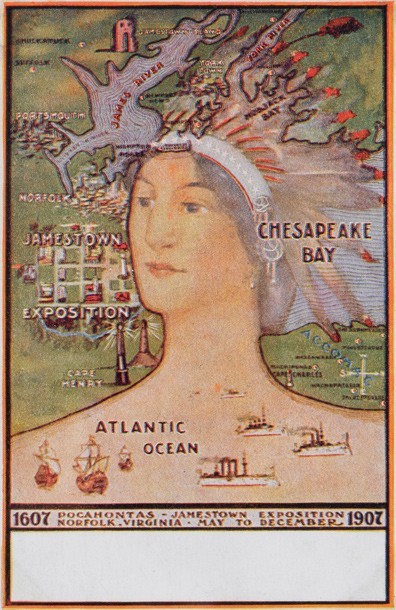
Souvenir postcard, United States, 1906. Cardstock. 3 1/2 x 5 1/2". (Unless otherwise indicated, all objects in author’s collection and all photos by Gavin Ashworth.) Stylized map of the exposition site, Virginia Capes, Jamestown Island, etc. in which the head and headdress of Pocahontas conform to the Chesapeake Bay and its tributaries. Note the unusual orientation, with west at the top.
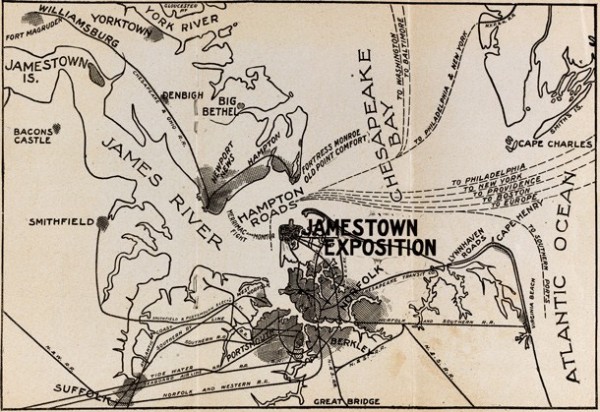
Back page of trifold Jamestown Tercentennial Exposition promotional pamphlet, United States, 1906. Paper. 9 1/2x 12". Less attractive but more functional than the image illustrated in fig. 1, this map provides considerably more detail, including the locations of Fort Monroe and the site of the legendary Monitor-Merrimack engagement as well as railroad and steamship routes.
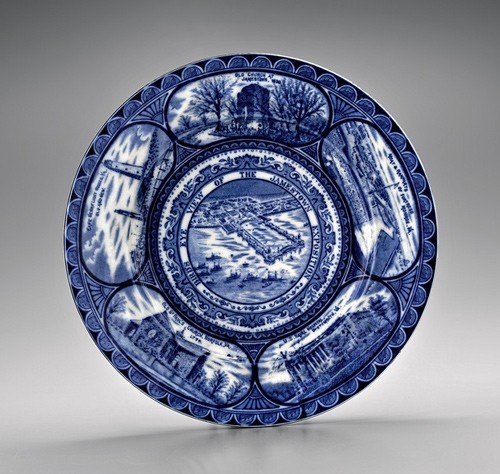
Dinner plate, StaVordshire, England, ca. 1907. Whiteware. D. 10 1/8". Transfer-printed souvenir plate with central motif of bird’s-eye view of the government piers at the Jamestown Tercentennial Exposition surrounded by cartouches of St. Paul’s Church in Norfolk, Cape Henry lighthouses, the church tower at Jamestown, Fort Monroe, and the U.S. Naval Hospital in Portsmouth.
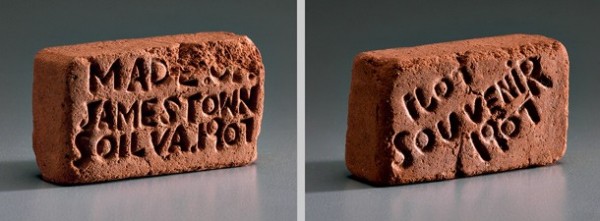
Miniature brick, United States, ca. 1907. Earthenware. L. 2". Marks: impressed on front, “MADE OF / JAMESTOWN / SOIL VA. 1907”; impressed on back, “1607 / SOUVENIR / 1907.”
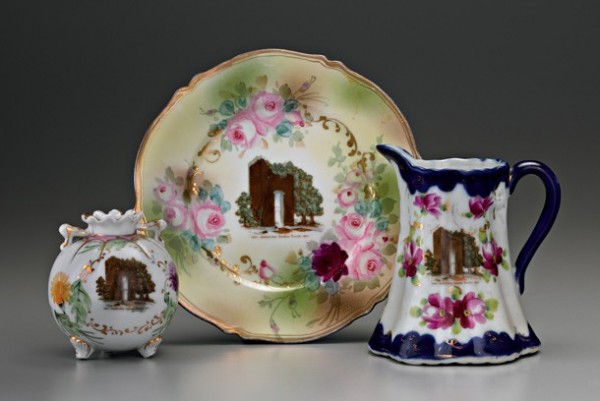
Globular vase, pitcher, and plate, United States or England, ca. 1907. Porcelain. D. of plate 7 1/2".

(Left to right) Pipe bowl with reed stem, probably United States, 1906, earthenware. Toothpick holder, probably United States, ca. 1907, porcelain. Miniature stein with pewter lid, Germany, ca. 1907, stoneware, H. 3 1/4".
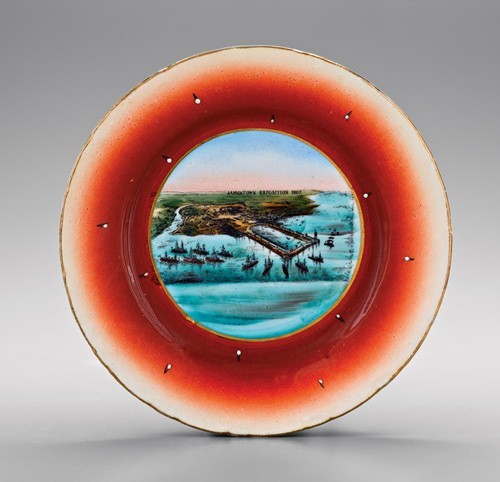
Dessert plate, A. C. Bosselman Company, New York, ca. 1907. Porcelain. D. 6 1/2".
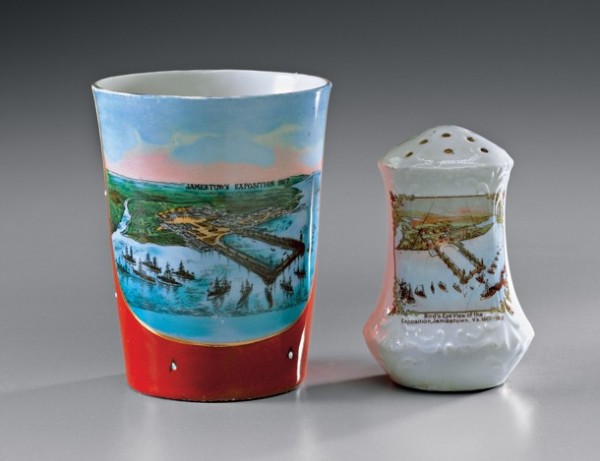
Beaker, A. C. Bosselman Company, New York, ca. 1907. Porcelain. H. 3 3/4". Pepper shaker, United States, ca. 1907. Porcelain. H. 3 1/8".

Stereoview picture of the Martin Gillette and Company’s exhibit at the Jamestown Expo’s Pure Food and Drug Building, with caption boasting “The biggest tea-pot on earth, holding a million cups,—Pure Food Exhibit, Jamestown, Va.” (Courtesy of the Hampton Roads Naval Museum.)
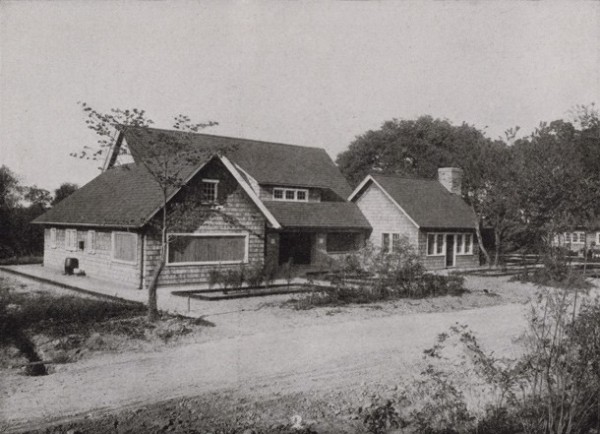
The Pottery Building at the Jamestown Exposition, reproduced in Glimpses of the Jamestown Exposition and Picturesque Virginia (Chicago: Laird and Lee, 1907), unpaginated.
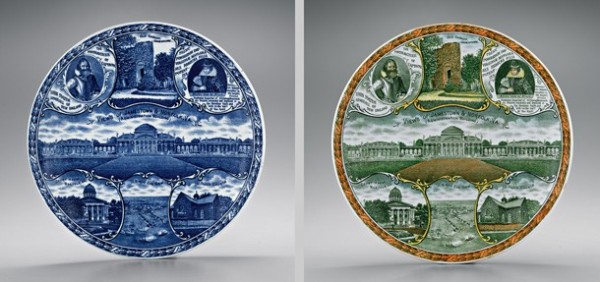
Pair of dinner plates, Staffordshire, England, ca. 1907. Whiteware. D. 10".

Pair of dessert plates, Staffordshire, England, 1906. Whiteware. D. 6".
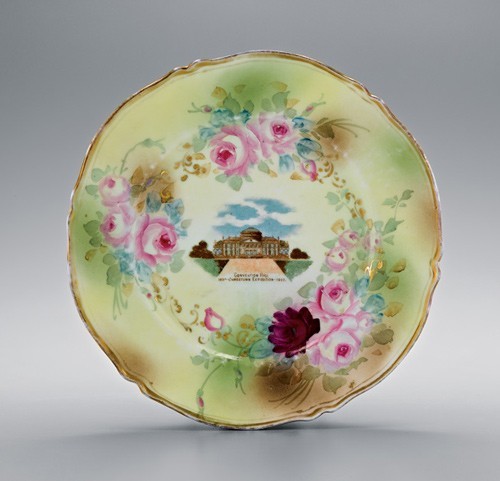
Dessert plate, probably England, ca. 1907. Porcelain. D. 7 1/2". Note the similarity of the border decoration to that of the plate illustrated in fig. 5.
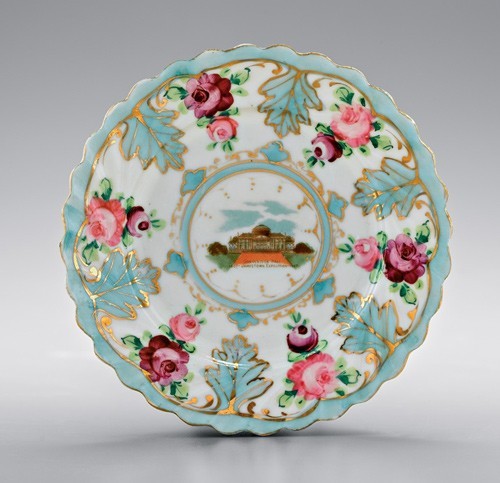
Saucer, probably England, ca. 1907. Porcelain. D. 6".
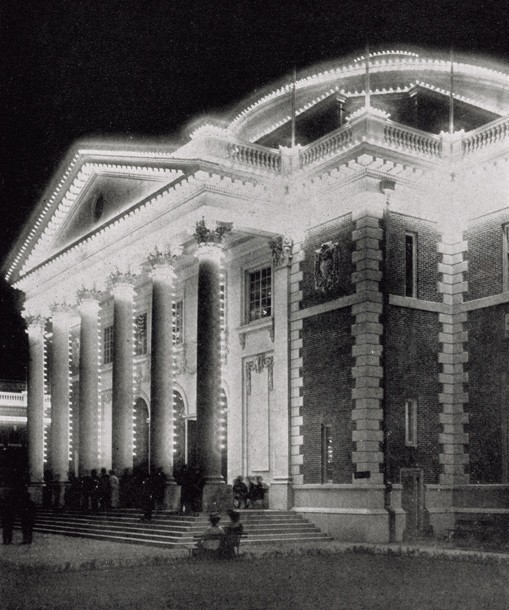
“Night illumination” of the Administration Building. Photo, reproduced from Illustrated Souvenir of the Jamestown Ter-Centennial Exposition (Norfolk, Va.: Seaboard Publishing Company, 1907), unpaginated.
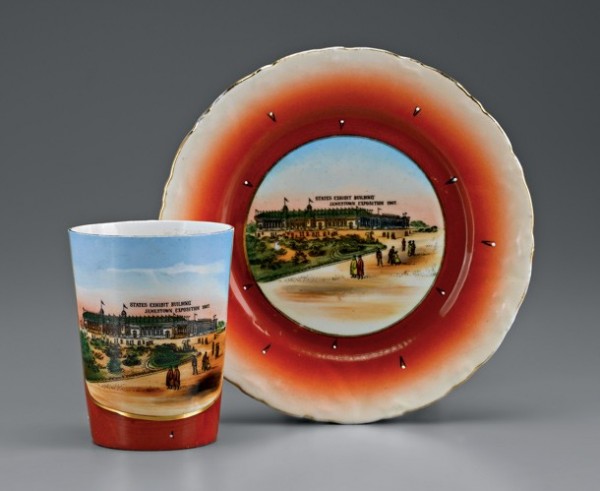
Dessert plate and beaker, A. C. Bosselman Company, New York, ca. 1907. Porcelain. D. of plate 6 3/4".
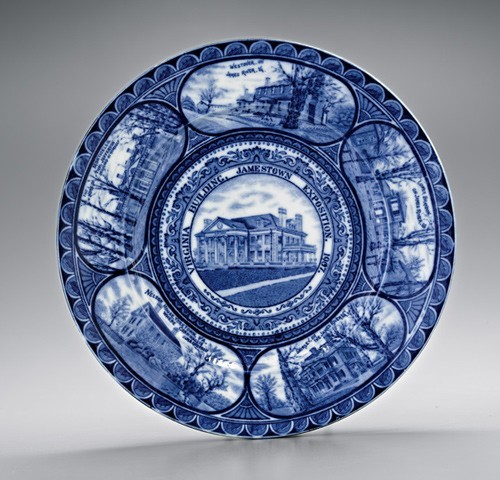
Plate, Royal Staffordshire Pottery, Burslem, England, ca. 1907. Whiteware. D. 10". This transfer-printed souvenir plate has a central motif of the Virginia Building surrounded by oblong cartouches depicting Virginia historic mansions.

Detail of the plate illustrated in fig. 22 (left), showing the inscription "ST. PAUL'S CHURCH, NORFOLK VA / SHOWING CANNON-BALL / FIRED BY / LORD / DUNMORE / 1776."

Dessert plates, Staffordshire, England, ca. 1907. Whiteware. D. 6 1/2". The central motif on these plates is the seal for the State of Virginia.
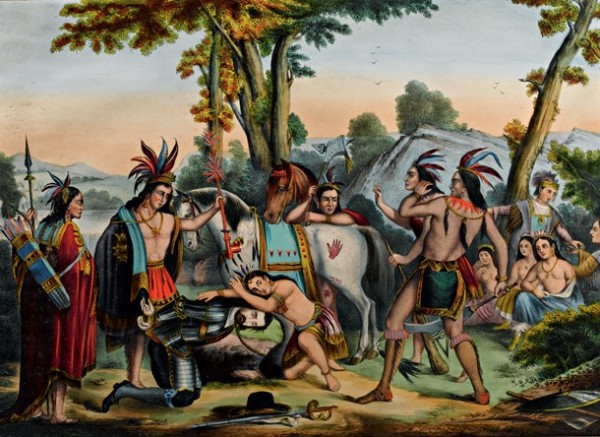
Print, United States, 1874. Paper. 23 3/4 x 29 1/2". By H. Schile of New York after a painting by Edward Henry Corbould.

Plate, Coshocton, Ohio, 1905. Tin. D. 10". The plate probably was made by either J. F. Meeks Tuscarora Advertising Company or H. D. Beach’s Standard Advertising Company.

Pair of plates, Rowland and Marsellus Company, Staffordshire, England, 1906. Whiteware. D. 10". One plate has a transfer-printed portrait of Pocahontas as the central motif, the other has John Smith, both with surrounding cartouches. The legend of the Pocahontas plate includes both her given name, Matoaka, and the one she received after baptism, “Rebecka” or Rebecca. Produced for the S. T. Hanger Company of Portsmouth, Virginia.
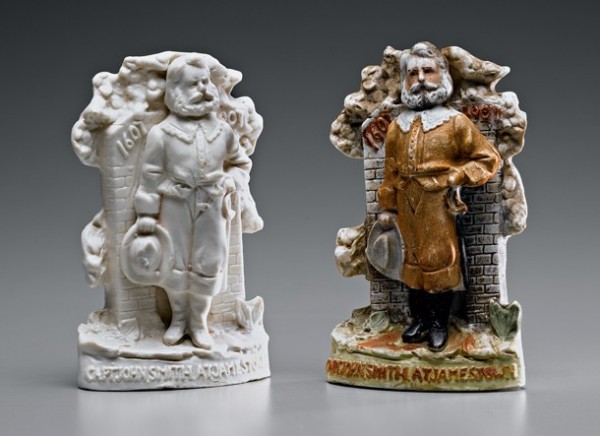
Pair of bud vases, United States, ca. 1907. Bisque porcelain. H. 4 7/8". Figural bud vases of John Smith in both unpainted and cold-painted enameled states.

A Pocahontas bud vase. (Photo, courtesy Hampton Roads Naval Museum.)

The Persimmon or John Smith Plate, Edwin Bennett Pottery, Baltimore, Maryland, 1906. Whiteware. D. 9 1/2". (Courtesy, Collection of Ken Beem; photo, Ken Beem.)
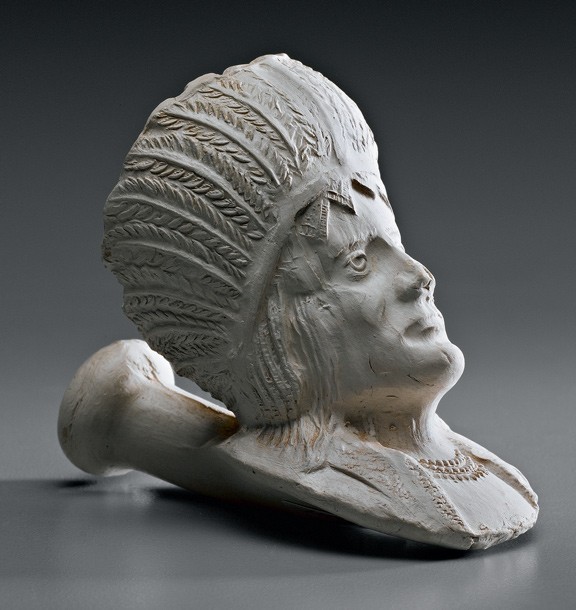
Pipe bowl, United States, ca. 1907. Unglazed earthenware. H. 2 1/4". This pipe bowl has been molded in the image of Chief Powhatan.

Stereoview card, United States, ca. 1907. Photo mounted on cardboard, 3 1/2 x 7".
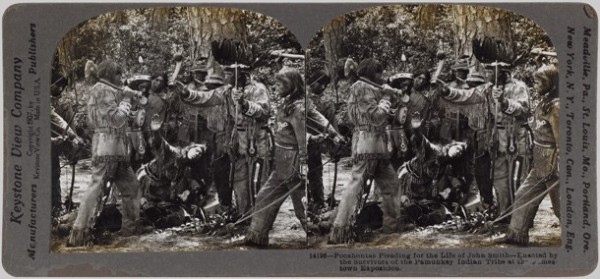
Stereoview card, United States, ca. 1907. Photo mounted on cardboard, 3 1/2 x 7".
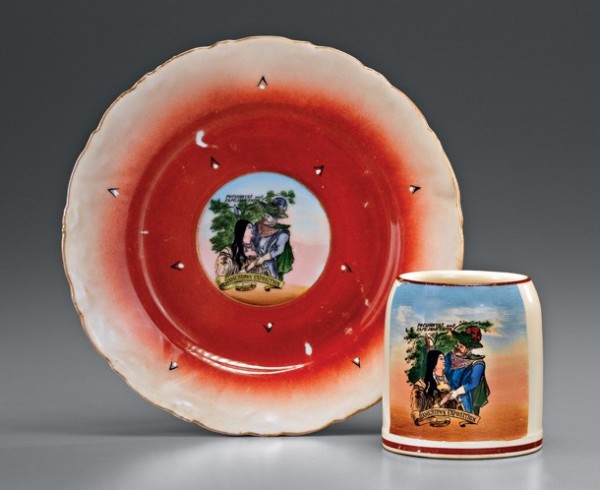
Dessert plate and mug, A. C. Bosselman Company, New York, ca. 1907. Porcelain (plate) and earthenware (mug). D. of plate 6 1/2".

Dessert plate, United States, 1907. Whiteware. D. 7 3/4". Transfer-printed image of the marriage of Pocahontas and John Rolfe, after an 1855 oil painting by Henry Brueckner.
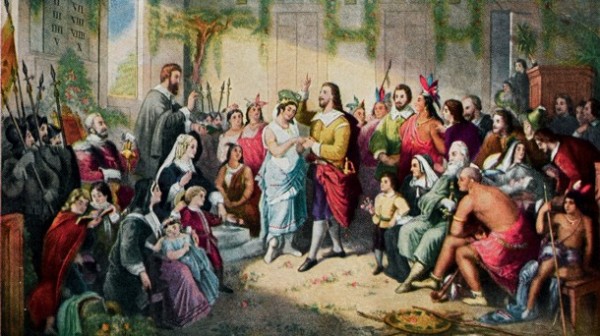
Postcard, “Marriage of Pocahantas,” United States, 1907. Cardstock. 3 1/2 x 5 1/2".
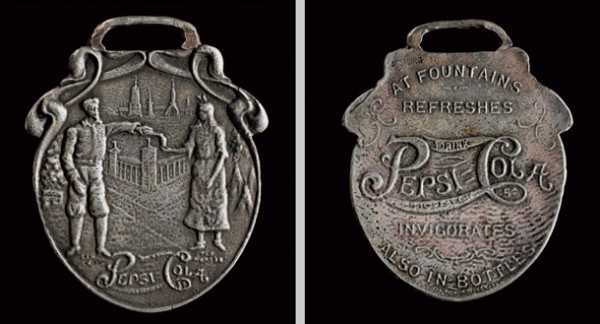
Watch fob, United States, ca. 1907. Silver. 1 1/2 x 1 5/8".
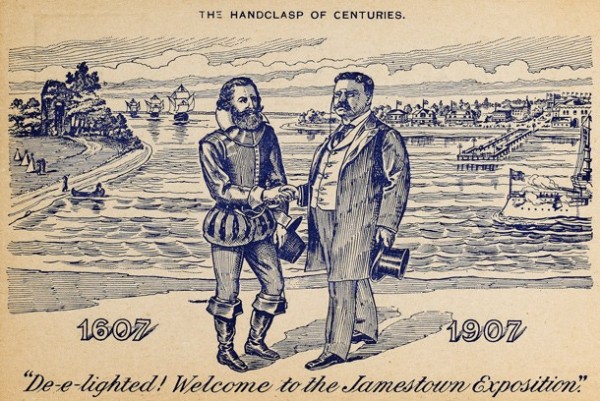
Postcard depicting “The Handclasp of Centuries,” United States, 1907. Cardstock. 3 1/2x 5 1/2".
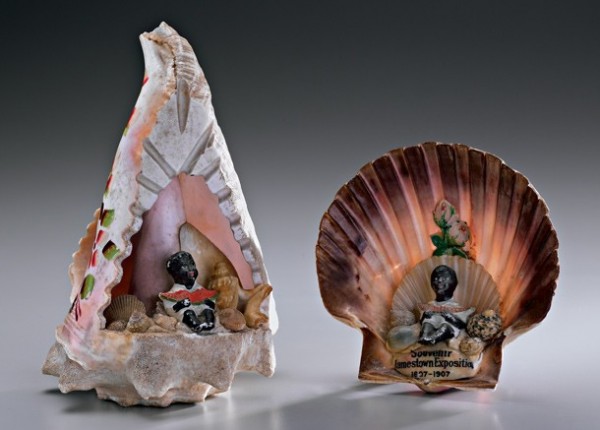
Dioramas, probably United States, ca. 1907. Shell and bisque. H. of larger diorama 6 1/4".
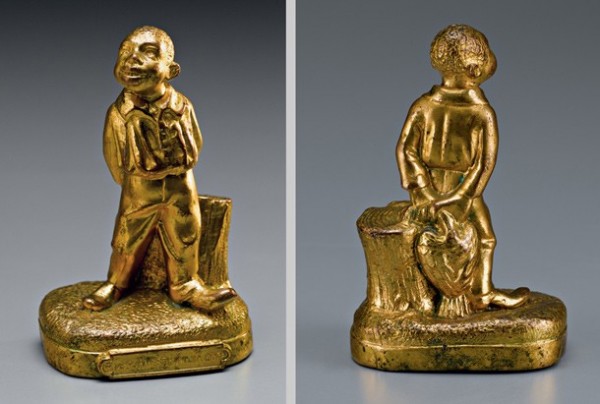
Figure, probably United States, ca. 1907. Gilt base metal. H. 3 3/4".
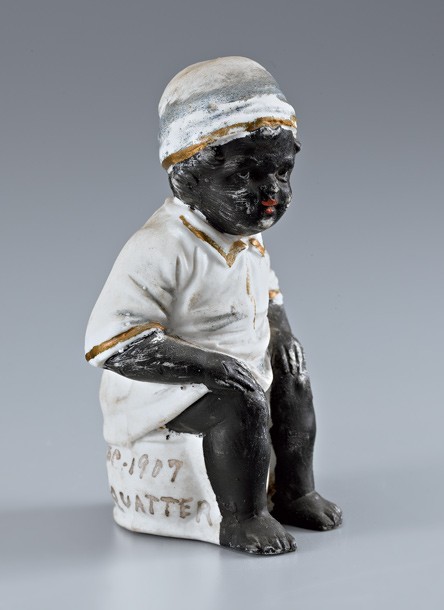
Figure, United States or Germany, ca. 1907. Bisque porcelain. H. 4 1/8". Press-molded, inscribed in ink: “1607 May – A – Dec - 1907 / Jamestown Squatter.”

Detail of the inscription on the base of the figure illustrated in fig. 36.
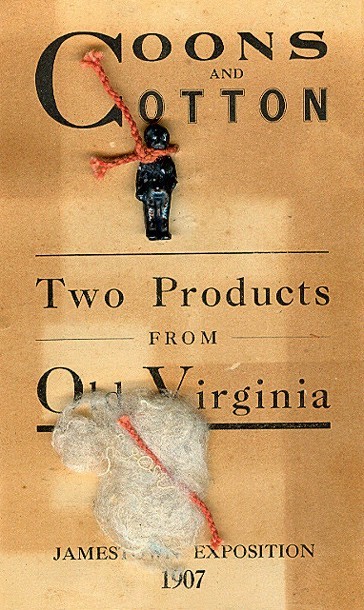
Postcard, United States, 1907. Cardstock, bisque, and cotton. 3 1/2 x 5 1/2". (Collection of Sally Carver; photo, Sally Carver.) Label: “COONS AND COTTON / Two Products / FROM / Old Virginia / JAMESTOWN EXPOSITION / 1907.”
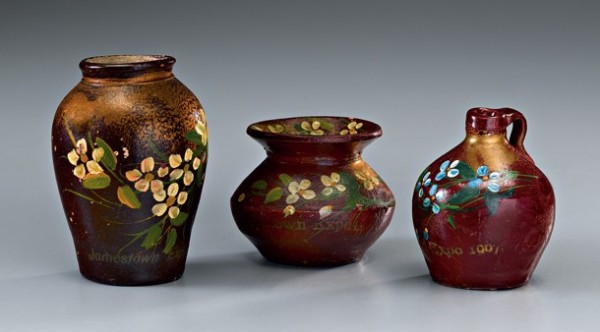
Miniature crock, urn, and jug, United States, ca. 1907. Red-glazed and enameled-painted earthenware. H. of crock 3 1/4".
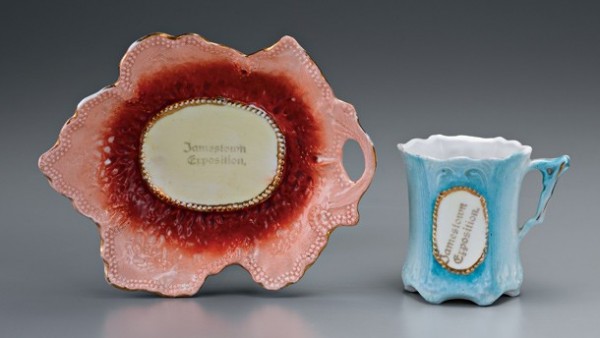
Cup and tray, Germany, ca. 1907. Porcelain. H. of cup 3".

Trifold postcard, Raphael Tuck & Sons, England, ca. 1907. Cardstock. 3 1/2 x 16 1/2". Entitled “Shore Promenade,” this postcard depicts a beautifully romanticized view of the fair, one that contrasts the genteel women in their late Victorian finery on one side with modern warships and steam yachts on the other.
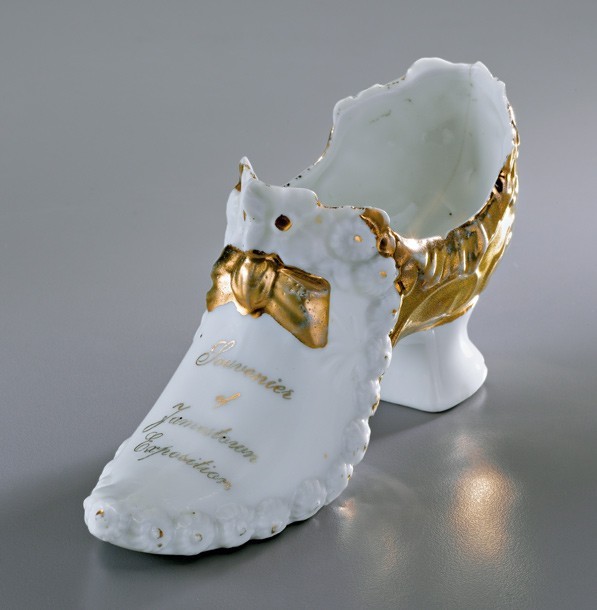
Shoe, America or Europe, ca. 1907. Porcelain with gilt accents. H. 2 1/2".

Figurines, Germany, ca. 1907. Porcelain. H. of tallest 3". Three piglets: one next to a bucket, another in a bag with a coin slot on top, and the third in a basket. The first two are labeled “Souvenir of Jamestown Exposition 1907,” the third simply “Jamestown Exposition 1907”; all with “Made in Germany” base stamp.
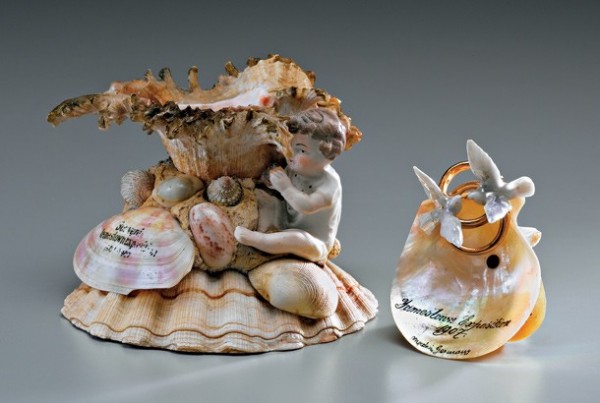
Montage, possibly United States, ca. 1907. Bisque and shell. H. 3 1/2". Labeled “Souvenir Jamestown Exposition 1607–1907.” H. of bisque figure 2 1/8". Ring holder, Germany, ca. 1907. Porcelain and shells. H. 1 7/8". Labeled “Jamestown Exposition / 1907 / Made in Germany.”

Figural box, United States or Germany, ca. 1907. Porcelain. L. 4 1/4", H. 2Q÷@". Hand-inscribed in ink, “1607 Jamestown Exposition 1907.”

Plaque, United States, ca. 1907. Bronze. 2 3/8 x 3 1/8". (Courtesy, Collection of Dan Carr; photo, Dan Carr.) Obverse of plaque commemorating the departure of the Great White Fleet from Hampton Roads barely two weeks after the closing of the Jamestown exposition. Designed by U.S. Mint sculptor Charles Barber. A profile bust of Theodore Roosevelt, designed by U.S. Mint sculptor George Morgan, is depicted on the reverse.
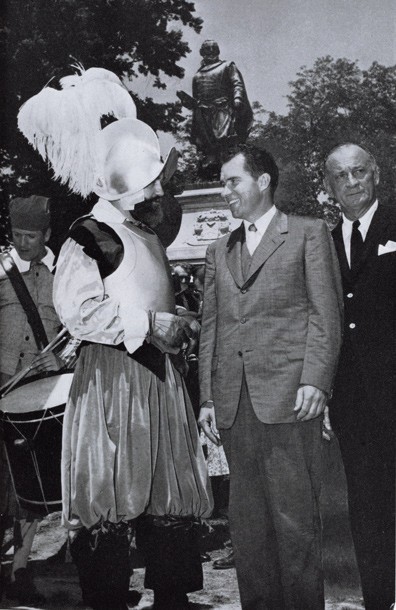
Unable to attend the Jamestown Festival of 1957 himself, President Dwight D. Eisenhower sent Vice President Richard M. Nixon in his stead. In a photo oddly reminiscent of “The Handclasp of Centuries” (see fig. 33), Nixon poses with the costumed actor portraying John Smith (illustrated in 350th Anniversary, p. 27).

Plate, Conrad Crafters Wheeling, Inc., West Virginia, 1955. Whiteware. D. 10". This example is dated “Dec. 2, 1955” and features a design taken from the 1907 Vienna Art Plate. Similar plates were produced by the Homer Laughlin Company.
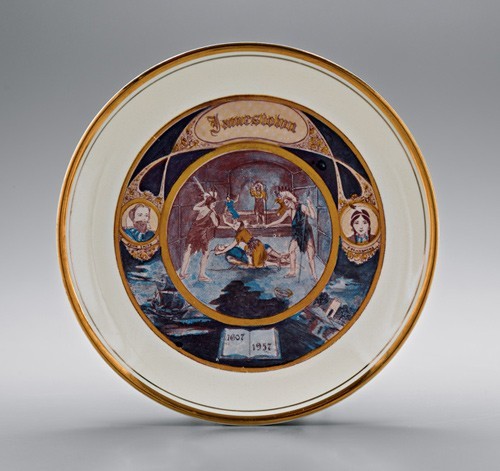
Dessert plate, Colonial China Company, South Hill, Virginia. Jamestown Souvenirs Newport News, Virginia, 1956. Whiteware. D. 7 1/2".
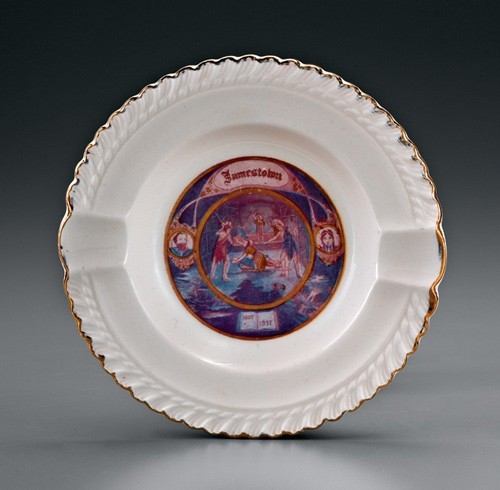
Ashtray, Colonial China Company. South Hill, Virginia, 1955. Whiteware. D. 5 1/2". Virginia copyright 1955 also featuring 1907 Vienna Art Plate design.
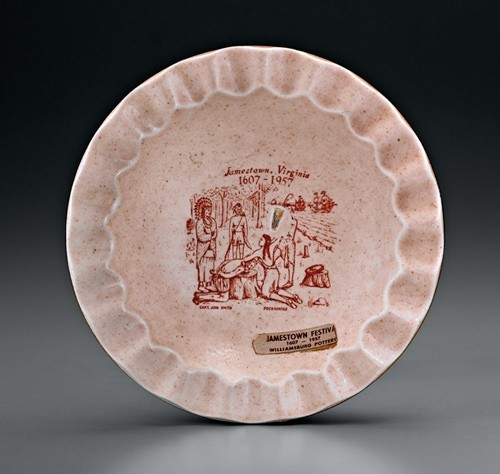
Ashtray, United States, ca. 1957. Whiteware. D. 6 1/8". Unmarked on the base but with attached sticker from the Williamsburg Pottery, a long-standing discount shopping mecca for area locals and tourists in Lightfoot, Virginia.
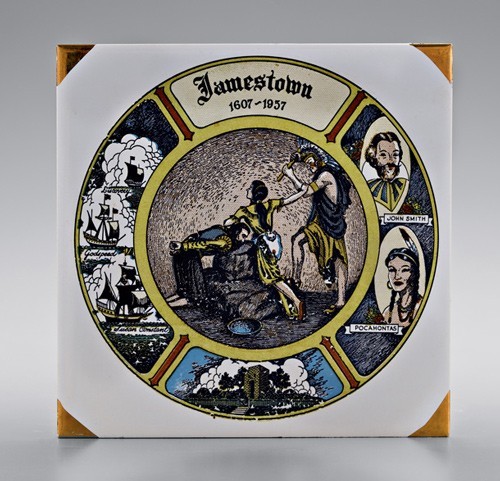
Tile, Germany, ca. 1957. Earthenware. 6 1/2" square. Mark: on back, “Made in Germany Danischburg”
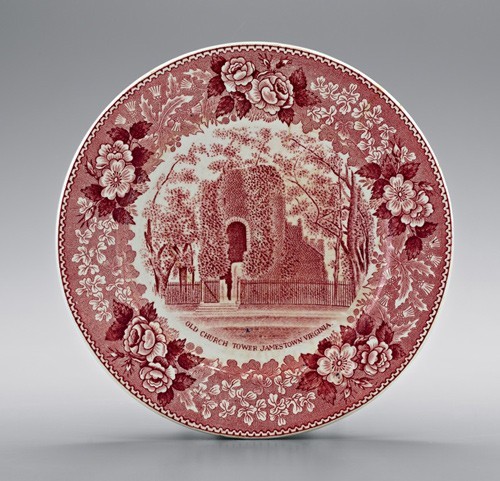
Dessert plate, Adams, England, ca. 1957. Whiteware. D. 6 3/4". Produced for the APVA on the “350th Anniversary of the Founding of the Nation, 1607–1957.” The plate was also produced in blue.
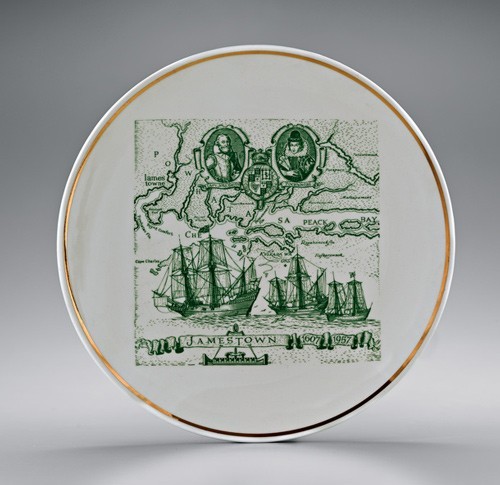
Dinner plate, Conrad Crafters Wheeling, Inc., West Virginia, ca. 1957. Whiteware. D. 9 5/16". The plate was also produced with brown and black transfer prints.
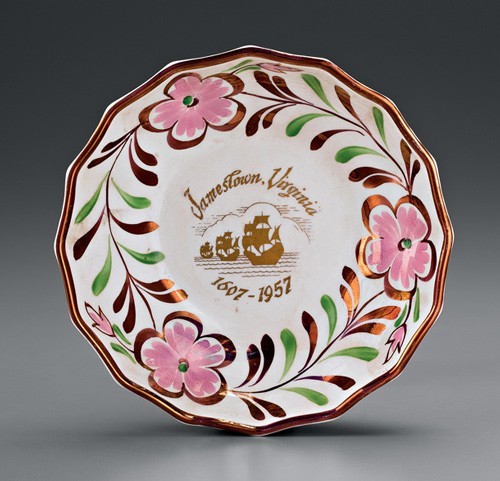
Dish, Gray’s Pottery, Stoke-on-Trent, England, ca. 1957. Whiteware. D. 5 5/8".

Dinner plate, Royal China Inc., Sebring, Ohio, ca. 1957. Whiteware. D. 9 7/8". The plate bears a transfer print of “Fort James” (James Fort) and a moored vessel surrounded by an English ivy border.

Cup and saucer, Adams, England, ca. 1957. Whiteware. D. of saucer 4 7/8". This dainty cup and saucer are perhaps unique among the 1957 ceramic souvenirs in incorporating all the popular images—church tower, Smith and Pocahontas, expedition ships, James Fort—and the Blair tomb on Jamestown Island to boot. Printed on the other side of the cup is an image of James Fort.
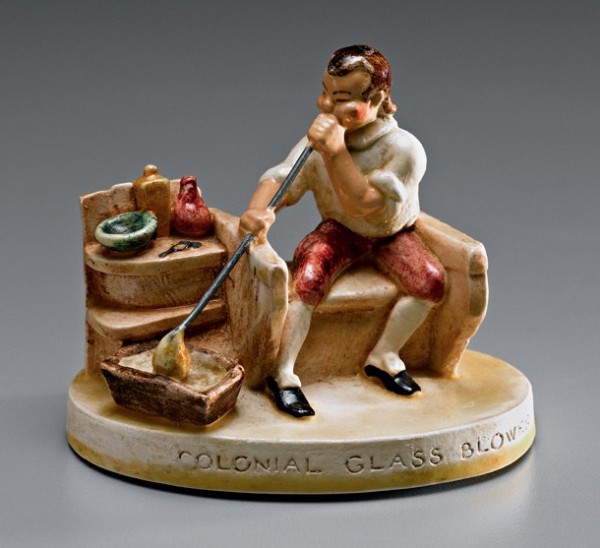
Figurine, American, 1957. Bisque porcelain. H. 2 5/8". Marks: inscribed on rim, “COLONIAL GLASS BLOWER”; base sticker, “A Sebastian miniature designed by Prescott W. Baston Marblehead Mass.” and “COPR 1957 P. W. Baston” impressed on back. Baston and his colleagues visited the festival park in 1957 and struck a deal with the gift shop to produce a series of four miniatures that also included the church, the fort, and the three ships.

Plates and mug, United States, 2007. Whiteware and porcelain. D. of largest plate 10 1/2". Ceramics from Jamestown 2007 generally represent slight stylistic variations of earlier motifs: the church tower; portraits of Pocahontas and John Smith; the expedition ships; and the 1907 Vienna Art Plate. The design of the fort plate (upper left), taken from a tracing of a 1608 John Smith map of Virginia sent to Philip III of Spain by his ambassador Pedro de Zuñiga, embodies one of the few innovations. Note that the version of the rescue scene on the 2007 plate (center) is essentially the same as the one employed on the 1957 German tile (see fig. 52). The mug displays the tri-sail logo of the 2007 celebration.
On the morning of April 26, 1907, three centuries to the day after the Jamestown colonists first sighted the Virginia Capes, Theodore Roosevelt steamed between the same headlands en route to Norfolk aboard the presidential yacht Mayflower. Passing through Hampton Roads—the historic body of water near the entrance to the Chesapeake Bay that witnessed the arrival of the first permanent English settlers in North America—Roosevelt received a booming salute from the United States Atlantic Fleet and warships of the many foreign nations that had assembled for the occasion. "It was an inspiring sight," the president later wrote, "and one I would not have missed for a great deal."[1] Alighting at Sewell's Point, Roosevelt's entourage made its way to a reviewing stand where at 11:30 a.m., followed by loud salutes from the assembled naval craft and shore batteries across the water at Fort Monroe, the president pressed a gold button to start the machinery of the Jamestown Tercentennial Exposition (fig. 1).[2]
The exposition was one of a series of international fairs staged throughout the United States following the success of the world's first, the Crystal Palace Exhibition in London in 1851. Organized to celebrate the 300th anniversary of Jamestown's founding, the expo was located approximately thirty-five miles down the James River, near Norfolk because of that city's more developed infrastructure and accessible location, and ran until late November (fig. 2). Compared to fairs such as those in Philadelphia (1876), Chicago (1893), and St. Louis (1904), the Jamestown Exposition was neither a commercial success nor did it attract visitors in impressive numbers. In fact, the New York Times dubbed it "the most colossal failure in the history of expositions."[3]
Yet the same article praised the fair for its "superb plans and exhibits." Even its critics conceded that it was "magnificent in construction and ideal in location" with landscapes that were "veritable dreams" and exhibits "finer than at many more pretentious expositions."[4] What accounts for the apparent discrepancy? Contemporary reports explain the reasons for the disappointing attendance and revenues. By opening day, construction of only about one-third of the expo's buildings and attractions had been completed. Some did not open until a month before the fair closed. Out-of-town visitors were dismayed by the "exorbitant rates charged by the hotels, restaurants and lodging houses." Transportation to the site by land and sea reportedly was "miserable" and could not have coped with the anticipated number of visitors. Worst of all, perhaps, members of the national press, irritated by their inadequate personal accommodations, heaped contempt on the endeavor, effectively discouraging their readership from attending. As a result, fewer than three million customers (and only about half of those paying) attended. By contrast, the 1893 expo in Chicago attracted more than twenty-seven million. Due to poor management and negative publicity, the Jamestown Tercentennial Exposition, a fair that had the potential "to be one of the greatest and most entertaining . . . international commemorative events ever held," instead came to be widely regarded as merely "a magnificent failure."[5]
Turnout and gate receipts are not the only measures of success, however. Among those well pleased with the outcome of the Jamestown Tercentennial Exposition was none other than President Roosevelt, who saw the fair as an opportunity to project an image of America's growing power and influence in the global arena. Within just the previous decade the United States had won an impressive victory in the Spanish-American War, gained new territories in the Caribbean and Pacific, and significantly expanded American commercial interests abroad. The nation was becoming a first-rate world power, and the president himself, by personally brokering the accord that ended the Russo-Japanese War in 1905 and earned him the Nobel Peace Prize, had attained the status of international statesman.
Given Roosevelt's imposing presence on the national and global scene and at the Jamestown fair itself, it is not surprising to see his image represented on a variety of expo memorabilia including postcards, celluloid pinbacks, sheet music, posters, and stereoview cards. Curiously, though, there appears to be not a single ceramic souvenir from the expo that bears his likeness. In fact, with relatively few exceptions, the designs on Jamestown Expo ceramics comprise only a few basic motifs: iconic images of the old church tower at Jamestown and first-settlement folk heroes John Smith and Pocahontas; expo buildings and views; and Virginia landmarks, attractions, and symbols. Yet even this limited array—and the exceptions to it—reveals much about a nation and a people striving, in the period of social and political ferment between the Civil War and World War I, to progress from second-rate power to global preeminence, from a slave-owning to a more egalitarian society, and from the Victorian era to the twentieth century.
Uncle Sam's Big Navy
Meet me on the warpath at the Jamestown Fair
Uncle Sam's big Navy and his soldier boys are there
Every body's merry and it's grand you'll all declare
Meet me on the warpath at the Jamestown Fair.[6]
As the three-hundredth anniversary of Jamestown's founding approached, two divergent, if not opposing, thematic visions emerged. Virginia organizers wanted to avoid a repetition of other recent expositions in the United States. As a contemporary journalist noted, "it was thought more fitting to emphasize the historical, educational, and social sides of the occasion than the commercial and industrial."[7] Specifically, Virginia planners sought to accentuate state and national history, highlighting the beginnings at Jamestown. But federal backers, spearheaded by the president, were anxious to showcase American military might and persuade the American people of the need to build and maintain a powerful navy.[8]
Ultimately, Roosevelt prevailed and, as one historian concluded, "shifted the focus from Jamestown to jingoism."[9] The administration threw itself wholeheartedly into the effort. "In no other similar exposition," the New York Herald declared, "has the national government taken so conspicuous a part."[10] The 1906 Act of Congress that furnished the initial appropriation for the Jamestown Expo decreed that the funds be used for holding "an International, Naval, Marine and Military Celebration" in which the armed forces of the United States would be featured prominently.[11] "Martial features, therefore," as a contemporary observer explained, were "plentiful and constant," with military attractions accounting for more than half of the expo's exhibits.[12] Foreign fleets and soldiers also were invited to participate, with the result that in the adjacent waters of Hampton Roads "every type of fighting craft, from the smallest gunboat to the largest man-of-war," lay at anchor, according to another viewer, and the military display ashore was "correspondingly elaborate."[13]
Roosevelt may have succeeded in projecting the image of the U.S. at the Jamestown Expo that he and fellow expansionists wanted to promote, but, for the most part, the ceramic souvenirs offer a perspective that was closer in outlook to what Virginia organizers had in mind. Produced in many cases by Staffordshire potteries at the behest of local merchants, these pieces primarily depict expo views and emblems of Virginia history that in some instances also had incidental military associations. For example, a combination of military and historical themes is evident on a flow blue Staffordshire plate that features as its central motif the expo's most recognizable image: a bird's-eye view of naval ships and the United States Government Piers in the foreground and the fair spread out along the shoreline beyond (fig. 3).
Surrounding the plate's central image are five oblong cartouches representing geographically and thematically diverse local landmarks of historical significance. Two of these, Fort Monroe in Hampton and the U.S. Naval Hospital in Portsmouth, have obvious military connections but probably were more highly esteemed by the plate's designer for their historical value, the fort site having been occupied by Englishmen since 1610 and the naval hospital having served American servicemen since its erection in 1835.[14] The most prominent cartouche directly above the bird's-eye view contains another of the expo's most distinctive images, the old church tower at Jamestown.
Crumbling Ruins, Holy Ground
Depicted in a contemporary guidebook as little more than "a few crumbling ruins on an uninhabited island," Jamestown nonetheless had achieved a venerable, almost sacred status among many Americans, especially Virginians, by 1907.[15] Writing that year for Century Magazine, Thomas Nelson Page characterized the ancient settlement site as the "birthplace of the American people . . . the tiny infant that has . . . sprung up to be . . . the torch-bearer of civilization."[16] Some nineteenth-century visitors described their journey to the island in spiritual terms. "I felt whilst there that I stood upon holy ground," avowed one. It was with "a sort of religious awe," armed another, "that I drew near to [the] venerable relicks of antiquity."[17] No doubt hoping to capitalize on similar sentiments, a resourceful entrepreneur produced ceramic miniature bricks impressed with the message "Made of Jamestown Soil Va. 1907" to sell at the expo (fig. 4).
Jamestown's most identifiable icon and the one that came to symbolize the first settlement at the tercentennial exposition was the church tower, the only seventeenth-century structure on the island that had managed to survive aboveground, albeit in a somewhat deteriorated state. During the 250th anniversary celebration in 1857 a correspondent for Harper's Weekly described the appearance of the building as "a square edifice of brick, now about thirty feet high, cracked and ruinous, and on one side overgrown with ivy," an image that appealed to early-nineteenth-century artists "who gravitated toward romanticized, melancholy scenes of decay and faded glory."[18] Such wistful representations appear on a number of expo items, including three small porcelain pieces—a globular vase, a pitcher, and a plate—all with the same transfer print charmingly framed in diverse hand-enameled floral borders (fig. 5). Similar depictions of the church tower were produced on a porcelain toothpick holder and a stoneware miniature stein with a pewter lid. The ruins also furnished the model for one of the most distinctive souvenirs produced for the fair: an earthenware pipe bowl, molded in the image of the church tower and fitted with a reed stem (fig. 6).
The Biggest Teapot on Earth
Most of the other edifices featured as central motifs on Jamestown Expo ceramics were impressive structures at the fair itself. The Government Piers consisted of two mammoth quays (one named Susan Constant and the other Godspeed, after two of the vessels that transported the first Jamestown colonists from England), each nearly a quarter mile long and 150 feet wide, joined at their ends by another pier of the same width with a graceful arch at its center to allow small craft to pass underneath. The forty-acre lagoon enclosed by the piers, the Grand Basin, offered a venue for water carnivals and a docking area for excursion boats. The sight must have been impressive, especially at night, since, according to one eyewitness, "a million incandescent lights illuminate the entire length of the pierway, and monster searchlights surmount the towers."[19] Similar bird's-eye views of the piers were transfer-printed onto a colorful porcelain plate and beaker, both manufactured by the A. C. Bosselman Company of New York, as well as a white pepper shaker with a molded leaf design (figs. 7, 8).
One structure apparently not represented on any ceramics but deserving of mention nonetheless is the Food Products Building, whose function at the fair clearly reflected the era of progressive reform that characterized American society and politics in the early twentieth century. All the building's exhibits featured goods—mostly tea, coffee, cereals, baking ingredients, and condiments—that strictly conformed to the standards of the Pure Food and Drug Act, passed in 1906 largely in reaction to Upton Sinclair's portrayal of the horrendous sanitary conditions in Chicago's meat-packing industry in his novel The Jungle.[20] The issue could not have been timelier. "Pure food shows were being held throughout the country, and the subject of food purity," the exposition's official publication declared, "was the paramount National issue."[21]
Among the displays, the He-No Tea exhibit contained perhaps the most extraordinary ceramics-related item associated with the Jamestown Exposition: the "biggest tea-pot on earth," complete with a dome-lid cupola sporting an acorn finial. Martin Gillette and Company of Baltimore operated a tea bar out of the eccentric attraction, which was based on the model of a "porcelain tea brewer" and purportedly large enough to hold a million cups (fig. 9).[22] The fair also contained an Arts and Crafts Village with another building worthy of special mention here: a Pottery Building in which, a souvenir booklet predicted, "Exhibition of all kinds of Pottery will attract every lover of ceramics to this beautiful village." Although the exhibit apparently did not include ceramics with depictions of the Pottery Building itself, a photographic image can be seen in figure 10.
Other structures featured on the fair's ceramics include the States Exhibits Building (or States Exhibits Palace) and a series of similar views variously identified in captions as the Administration Building, Convention Hall, and the Auditorium. The apparent name confusion stems from the fact that the Auditorium, an annex built behind the Administration Building, hosted conventions and other gatherings by day and provided the locale for classical music concerts at night.[23] Described by contemporaries as "the central and most beautiful building upon the grounds" and a "handsome building . . . admired without stint by every one," the Administration Building housed the principal offices of the Jamestown Exposition Company and served as the managerial nerve center of the fair.[24] It was connected by colonnades to the Historic Art Building on one side and the Education and Social Economy Building on the other, as can be seen on a pair of Staffordshire dinner and dessert plates, the former designed and imported by Max Schwann of Norfolk and the latter created for the S. T. Hanger Drug Company of Portsmouth. Each design was produced in both blue and green varieties (figs. 11, 12). A more schematic view, without the adjacent buildings and colonnades, appears on a porcelain saucer and dessert plate, both with elaborate, polychrome floral and foliate borders and gold trim (figs. 13, 14).
Echoing the historic theme of the fair, the neocolonial-style Administration Building complex formed "the centerpiece for the architectural design of the Exposition" according to the official guidebook.[25] "Wired so that every detail stood out in sparkling lines against the dark blue of the Southern sky," the set of buildings also provided one of the fair's more dramatic examples of "night illumination," still a relatively new phenomenon in 1907. "It was the slow turning on of the thousands of lights," an enchanted viewer reported, "which created the greatest delight of anything at the Exposition, especially for those of the slightest artistic or romantic temperament" (fig. 15).[26]
Hail! To the Mother of States
Virginia dear old commonwealth
The Mother of States and Presidents . . .
Here's to old Virginia Home of Washington and Lee
In deeds that were glorious they were victorious
Hail! To the Mother of States[27]
Measuring 300 by 500 feet with 200,000 square feet of interior space, the States Exhibits Building (fig. 16) was one of the fair's largest structures and contained displays from seventeen states, Los Angeles and San Diego counties, several railroad companies, as well as various agricultural and industrial exhibits.[28] In addition to these displays, twenty-one states (including all of the original colonies except South Carolina) responded to the expo organizers' invitation to each state to construct its own freestanding building. In keeping with the expo's historical theme, many produced smaller-scale replicas of their own venerable seventeenth- and eighteenth-century structures, such as Boston's Old State House, Philadelphia's Independence Hall, and Georgia's Bulloch Hall, the family home of Theodore Roosevelt's maternal ancestors.
Other states, such as New York and West Virginia, built imposing neocolonial structures from new designs. Predictably noteworthy among these was the two-and-a-half-story Georgian Revival representation of a Virginia planter-merchant's mansion designed by two Norfolk architects for the host state. Lauded by the expo's Official Guide as "the handsomest and most prominent of all the State buildings," the Virginia Building (or House) was surrounded by a wide veranda with one-story porticoes topped by balconies on either side.[29] The stately home also featured twin chimneys and roof dormers on each side and a two-story, pedimented front portico supported by four graceful columns that combined "the harmonious effects of Ionic elegance with Doric simplicity."[30] Designed exclusively for reception and entertainment, the building contained no exhibits. Instead, a writer proclaimed in a pre-expo promotional essay, it was here that "Virginia, the 'Mother of States,'" would "proudly act the role of hostess to her children who have wandered far and are coming back again during the Exposition."[31]
Strikingly depicted on a blue-and-white transfer-printed plate produced by the Royal Staffordshire Pottery for the Nussbaum Book and Art Company of Norfolk, the building appears as the central motif of an elaborate Virginia montage (fig. 17). Framed by an ornate foliate border, the house is further encircled by five oblong cartouches around the rim, each depicting an actual Virginia historic mansion. All but one, Thomas Jefferson's magnificent Monticello in Charlottesville, are located in the state's Tidewater region, along the banks of the rivers bounding the peninsula that contains the celebrated historic triangle of Jamestown, Yorktown, and Williamsburg. Built in 1740, Yorktown's Nelson House was occupied during the Revolution by the British when its owner, commander of the local Virginia militia and subsequent Declaration of Independence signer Thomas Nelson Jr., famously ordered his troops to train their cannons on his home. The house saw additional action during the Civil War when it was occupied by the Confederates under General Jeb Magruder and bombarded by Union forces.[32]
While the Nelson House faces the York River, the three other Tidewater homes are all located "on James River," as their cartouche captions indicate. Described in a 1907 essay as "the most perfect specimen of Colonial architecture existing today" apart from Monticello, Westover was the home of Colonel William Byrd, and Shirley the birthplace of Ann Carter, wife of Revolutionary War hero Henry "Lighthorse Harry" Lee and mother of Civil War general Robert E. Lee.[33] Located on the north bank, these plantation houses constituted two of the several "manorial seats that formed the grandees' row of James River mansions" beginning in the late seventeenth century.[34] Situated across the river in Prince George County, Lower Brandon was built about 1765 by Nathaniel Harrison II and is the ancestral home of Presidents William Henry Harrison and Benjamin Harrison. According to Harrison family tradition, the home was designed by family friend Thomas Jefferson based on a villa plan by Italian architect Andrea Palladio, whose work had influenced Jefferson's blueprint for Monticello.[35] The three James River homes were singled out for praise in 1907 by Theodore Roosevelt who, having visited them on a boat excursion the day after he inaugurated the Jamestown Tercentennial Exposition, described them in a letter to his son, Kermit, as "three of the dearest places you can imagine."[36]
Other historic landmarks depicted in vignettes on the borders of expo souvenir plates include two churches, St. Paul's in Norfolk (see figs. 3, 11, 22) and Williamsburg's Bruton Parish (see fig. 22). Erected in 1739, St. Paul's came under fire from the British fleet in Norfolk's harbor under the command of Lord Dunmore on New Year's Day, 1776, and was struck by a cannonball. More than seventy years later, the projectile was dug up and cemented in the hollow it had created, a fact alluded to in the legend of one of the cartouches (fig. 18).[37] Founded in 1632, Bruton Parish is one of the nation's most venerable churches, counting among those who worshiped there colonial governors and members of the House of Burgesses as well as such luminaries of the young republic as Washington, Jefferson, Madison, Monroe, and Patrick Henry. Prominently featured in the cartouche view is the bell tower, part of the current structure that was completed in 1715 and has been in active use ever since.[38]
Naval and shipbuilding complexes, recreation areas and facilities, lighthouses, and urban buildings were some of the additional landmarks portrayed. Like most of the plantation homes, all were located in southeastern Virginia, relatively close to the expo itself. Many fairgoers stayed at the Pine Beach Hotel near the fairgrounds or the Chamberlin across the water in Hampton and enjoyed the beach at Ocean View (see fig. 12). Few likely made the trip to visit the "Torpedo Flotilla" or the "Wet Dock" in the Elizabeth River near Norfolk and Portsmouth, or "The Largest Dry Dock in the World" up the James River in Newport News (see fig. 19). Many similar naval craft were anchored directly offshore of the expo, however, and fair visitors also could have observed a scaled-down replica warship being "docked and undocked each day" at the Navy's model drydock exhibit in the Government Building.[39]
Besides such local attractions, Virginia herself is highlighted on the dessert plates produced for Max Schwann (see fig. 19). With the state seal as the central motif, these Staffordshire pieces were produced in either blue or green on a white background and, in a rare example, blue with rust and tan highlights. Designed principally, it is thought, by Declaration of Independence signer George Wythe and approved at the 1776 Virginia Constitutional Convention, the state's Great Seal features the imposing figure of Virtus, the Roman goddess of Virtue, standing over the fallen figure of Tyranny with the motto "Sic Semper Tyrannis" (Thus Always to Tyrants) displayed below, an unambiguous reference to the revolutionary struggle in which the colony was then engaged. The physical appearance of Virtus (also known as Fortitudo or Courage), which has been characterized as "a bit rough or masculine," was based on the model of an Amazon. Due to a profusion of variations, a committee was established in 1930 to standardize the design.[40] This likely explains why Virtus's drapery falls from her left shoulder on the Schwann plates and from the right on the current Great Seal. Victorian sensibilities, however, probably account for the fact that one of her breasts is fully exposed on the original and current state hallmark but only partially so on the 1907 ceramic piece.
The image of Virtus hints at a peculiar paradox of the Jamestown Expo: that despite its emphasis on military pomp and display (almost exclusively masculine endeavors in that era), the fair also had a decidedly feminine, if not feminist, aspect to it. In fact, declared The Ladies' World magazine in May 1907, "Never was there a great exposition in which the underlying cause was more attributable to women," asserting that "Virginia, taking her name in honor of a woman," had been "made beautiful in her institutions and homelife by generations of noble womanhood." Assessing the impact of women on the expo itself, the journal cited the contributions of the Colonial Dames, Daughters of the American Revolution, and United Daughters of the Confederacy, who had gathered much of the material for the historical and educational displays.[41] In addition, it was the female-dominated Association for the Preservation of Virginia Antiquities (APVA) that almost single-handedly undertook the restoration of Jamestown ("our modern Pompeii," as one APVA officer described it) in the late nineteenth century and made the site more welcoming and accessible to visitors in 1907.[42] Women also played a major role in organizing the exhibits at the Social Economy Building (a first at the 1907 expo) and the Mothers' and Children's Buildings, in which the National Congress of Mothers (now known as the Parent Teacher Association) and the National Council of Jewish Women presented important issues of the day, such as child labor and public health.[43]
Women were not especially visible, however, among the fair's visiting dignitaries and celebrities, at its exhibits and attractions, and (apart from Virtus) on expo souvenirs—with one remarkable exception. As described more than six decades before the exposition, this unique female was "one of those characters, rarely appearing on the theatre of life, which no age can claim, no country appropriate. She is the property of mankind, serving as a beacon to light us on our way, instruct us in our duty, and show us what the human mind is capable of performing when abandoned to its own operations."[44] The exception, of course, was Pocahontas.
He Gives Me Fever
Captain Smith and Pocahontas
Had a very mad affair
When her daddy tried to kill him
She said Daddy, oh don't you dare
He gives me fever
With his kisses, fever when he holds me tight
Fever, I'm his missus
Daddy, won't you treat him right.[45]
Pocahontas (or Matoaka) was the favorite daughter of Powhatan (or Wahunsonacock), chief of the Indian confederacy that bears the same name. John Smith was the English adventurer who, despite frequent conflict with social and political superiors, is generally credited with saving the early Jamestown settlement from utter disaster. "Ravaged by fever and sickness, attacked by savages and torn by internal dissension," a historic Jamestown Expo guidebook explains, "the colony was only held together by the indomitable spirit of Smith."[46] Smith could not have succeeded, however, without the aid of Pocahontas, described by another 1907 source as "the guardian angel of her new-found friends."[47]
Smith not only acknowledged the colony's debt to Pocahontas but paid tribute to her for saving his own life during an event that has become legend. According to Smith's account, he was dragged before Powhatan and forced to the ground with his head lying on "two great stones." Referring to himself in the third person, Smith further related that when the Indians prepared "with their clubs, to beate out his braines, Pocahontas the Kings dearest daughter, when no intreaty could prevaile, got his head in her armes, and laid her owne upon his to save him from death."[48] Many have since questioned whether the incident occurred or, if it did, whether it was actually a native ritual in which Smith's life was never truly in danger.[49] Regardless, the event achieved a mythical status and has been memorialized in artistic representations since the 1620s.
One such depiction, a splendid 1874 print (fig. 20), may have provided a model for the tin lithograph Vienna Art Plate (fig. 21) produced in 1905 for the Jamestown tercentennial.[50] The plate does not contain some of the fanciful elements of the print, such as the horse and waterfall, neither of which would have been part of the southeast Virginia landscape in the early seventeenth century, but Pocahontas's protective pose and the Indians' garb are similar in both renditions. The Indian maiden, who was only about twelve years old at the time, appears to be older than that, especially on the plate, not only in the central motif but also in a cameo on the rim opposite one of Smith. The flattering and sentimental pairing, in which their age difference appears to have been minimized, further implies a special relationship between the two. The Jamestown folk heroes also appear, individually, as the central motifs on a pair of Staffordshire portrait plates produced for the S. T. Hanger Company (fig. 22), as cameos on the Administration Building dinner plates (see fig. 11) and as a pair of three-dimensional figural, ceramic bud vases (figs. 23, 24).
The Washington, D.C., chapter of the APVA honored the English captain by issuing a commemorative ceramic dish known as the Persimmon, or John Smith, Plate (fig. 25). Produced in 1906 by the Edwin Bennett Pottery Company of Baltimore, the plate features Smith's crest surrounded by a border of persimmons, a fruit to which he was introduced in Virginia.[51] Smith's description of the "putchamins" from his Generall History is printed on the back.[52] The coat of arms displays three Turks' heads, a direct reference to three Turkish champions he had killed and beheaded in successive single combat duels during another legendary, pre-Virginia adventure.[53] Powhatan's image is not nearly as ubiquitous among tercentennial mementos as those of Smith and Pocahontas, but it does appear on several expo items, including a scarce ceramic pipe bowl in which the chief is depicted with flowing hair and an elaborate feather headdress (fig. 26).
Fairgoers had the opportunity to observe not only small and inanimate portrayals of these historical figures and events but also life-size and even live representations of them. The Smithsonian Institution created for the expo an intricate full-scale diorama, complete with Indian dugout canoe and small English coasting vessel, entitled "John Smith Trading with the Indians" (fig. 27).[54] In it a native woman offers one of the settlers "something worse than a lemon," according to a 1907 viewer, and he "is making a face over it," no doubt reflecting Smith's warning about the persimmon: "If it be not ripe it will draw a man's mouth awry with much torment."[55] And in a performance recorded for posterity on a series of stereoview cards, a group of Pamunkey Indians (part of the Powhatan confederacy) nightly reenacted the Smith-Pocahontas rescue incident, though at least one disappointed spectator found "their war whoops . . . deficient in animation and abandon" (fig. 28).[56]
Whether or to what extent Smith ever actually gave Pocahontas "fever" has been the subject of considerable speculation and debate over the years. The suggestion goes back as far as 1612, when two of Smith's fellow colonists asserted that he could have married her.[57] A 1755 account unequivocally declared that what motivated the Indian princess to save Smith from execution was love at first sight, a notion that modern-day film versions, such as Disney's 1995 animated Pocahontas and The New World of 2005, have done little to dispel.[58] Similarly, and to a greater extent than the Vienna Art Plate and the Staffordshire pieces that feature the purported lovers' images, two other Jamestown Expo ceramic souvenirs hint at a romantic attraction. Produced by the A. C. Bosselman Company, both a porcelain saucer and a small earthenware mug employ the same transfer print showing the couple holding hands and gazing affectionately at one another (fig. 29).
A corollary to the seemingly irresistible tendency in the popular mind to imagine a romantic liaison is one that assumes that the bond ultimately led to marriage.[59] As New York State's official chronicler for the Jamestown Expo lamented, "it would seem a most fitting finale that Pocahontas should marry Captain John Smith . . . yet history is not made entirely from romance as the reader of novels would have it, and one has to accept events as they come."[60] To the disappointment of centuries of romantics, Pocahontas married not the swashbuckling John Smith but the more pedestrian John Rolfe, the entrepreneur who rescued the colony economically by successfully promoting the production of tobacco as a cash crop. Their marriage in the church at Jamestown, with rays of sunlight streaming through the window behind them, was depicted in a captivating 1855 oil painting by Henry Brueckner that presents an appealing but sadly ephemeral vision of racial harmony and peaceful coexistence between the settlers and the natives. The image was reproduced on a dessert plate by the Nusbaum Book and Art Company of Norfolk that makes no mention of the exposition, but the impressed mark "3-07" on the back appears to indicate a production date just before the opening of the expo and the subject matter clearly corresponds (fig. 30). Moreover, an error in the marriage date on the plate suggests another connection. The wedding took place in April 1614, but an official expo souvenir postcard (fig. 31) gives the date as 1613.[61] Possibly using the same source of information, the producers of the Nusbaum plate compounded the error, through incorrect observation or transcription, by listing the marriage date as April 1813.
In an effort to draw the connection between the worlds of 1607 and 1907, depictions of Pocahontas and John Smith were reproduced on countless exposition items, including not only ceramics but medals, watch fobs, brooches, trays, pocket knives, scissors, spoons, paperweights, tumblers, and United States postage stamps. Two items in particular reveal how their images were exploited in ways that transcend simple souvenir sales profits: a sterling silver watch fob produced by the Pepsi-Cola Company on which a figure resembling Smith pours a beverage into the glass of an Indian maid with the fairgrounds in the background (fig. 32); and a postcard entitled "The Handclasp of Centuries" that depicts John Smith and Theodore Roosevelt shaking hands, with both 1607 Jamestown and the 1907 expo as backdrop, thus making explicit the link between America's heroic past and its bold, assertive early-twentieth-century present (fig. 33).
No Rebels or Yankees Now, Americans Are We
People from the North will come and bring their boodle,
And be made to feel at home when they hear "Yankee Doodle!" . . .
All of the Southerners will be there with the glad hand,
And will also feel at home when they hear "Dixie Land." . . .
No "Rebels" or "Yankees" now, Americans are we,
And with all the world tip our hats to "My Country 'tis of Thee."[62]
Americans in 1907 were about as far removed in time from the Civil War as present-day citizens are from the Vietnam War. Both conflicts bitterly divided the nation, but with much of the South left in ruins and more than half a million dead—including, as its final casualty, a sitting U.S. president—the emotional scars of the Civil War ran deeper and healed with greater difficulty. It is not surprising, then, that national promoters of world's fairs in the postbellum era consciously sought to use the medium to "hasten the transformation of the recently reunited states into the United States."[63] As a result, "signs of sectional accord abounded" at fairs that were "supercharged with symbols of patriotism designed to promote sectional reconciliation."[64]
The phenomenon was especially noteworthy at the Jamestown Exposition because it was held not very far from the Confederate capital, Richmond, in an area that witnessed many of the war's principal battles and campaigns. In fact, the first skirmish of the war in Virginia, the Battle of Sewell's Point, occurred in May 1861, when the USS Monticello steamed from Old Point Comfort in Hampton and shelled Confederate troops erecting defenses on the future site of the fair.[65] Reminders of that and subsequent engagements were close at hand throughout preparation of the grounds for the expo. The New York Herald reported that a "surprising quantity of bullets, pieces of shell and broken muskets" from the fighting in the 1860s was unearthed during construction.[66]
At the fair itself, two of the most popular attractions were a movingscenery cyclorama or "spectatorium" of the epochal Battle of Ironclads between the Monitor and Merrimack (alias CSS Virginia) and daily reenactments with replicas offshore, supposedly "on the exact site of the original engagement."[67] In addition, Confederate veterans camped and marched at the fair and former supporters of the Southern cause were honored on various "special days" throughout the expo calendar.[68] All of this appears to have been undertaken in a spirit of nostalgia, not bitterness or defiance. Both sides, it seems, wanted nothing more than to put sectional differences behind them. The New York Herald, for example, noted with joyful amazement "the very friendly grouping of buildings" at the expo in which the "geographical or sectional grouping of the States has been completely lost."[69] Echoing similar sentiments, the issue of Confederate Veteran that reported on the expo declared, "We rejoice today in the unity of our country. The North and the South are rapidly in spirit becoming one."[70]
Overt expressions of sectional reconciliation evidently are absent from the expo's ceramic souvenir assemblage, but the appearance of Fort Monroe on a number of these pieces may represent a discreet, understated example of the trend (see figs. 3, 19, 22). The bastion had a long history preceding the Civil War, of course, but for ex-Confederates, especially local Virginians, its wartime associations would have been decidedly negative. It was here, after all, that three runaway slaves sought refuge in May 1861, prompting Union general Benjamin Butler to declare them "contraband of war." Butler refused to surrender the slaves to the Southern officer who came to the fort under flag of truce seeking their return, thus establishing the North's policy regarding runaways and further prodding President Abraham Lincoln to call eventually for full emancipation.[71] Also, it was during an impromptu visit to the fort in May 1862 that the increasingly impatient president ordered his excessively wary Union commanders to take the offensive, including shelling enemy batteries at the future exposition site.[72] And, perhaps most bitter of all for supporters of the Southern cause, Fort Monroe was where Confederate president Jefferson Davis was imprisoned at war's end, "shackeled [sic]," in the words of a Virginia historian in 1922, "like an ordinary criminal" in a cell that conveyed "no pleasant ideas of the magnanimity of his conquerors."[73] The mere presence of the fort's image on the expo's ceramic souvenirs, therefore, might reflect the more general movement toward sectional harmony.
Coons and Cotton
Carry me back to old Virginny,
There's where the cotton and the corn and tatoes grow,
There's where the birds warble sweet in the springtime,
There's where the old darkey's heart am long'd to go.[74]
As gratifying as the reconciliation between North and South may have been for many turn-of-the-century Americans, it was not without cost, the brunt of which was borne by America's former slaves. In what one historian has described as the post-Reconstruction "acquiescence of the rest of the country in the South's demand that the whole problem be left to the disposition of the dominant white people," the North, in exchange for the South's return to the union, tacitly agreed not to insist too vigorously that liberated slaves actually receive the rights accorded to them by the thirteenth, fourteenth, and fifteenth amendments to the U.S. Constitution.[75] Despite the promise of freedom that emancipation was supposed to bring, the condition of blacks in the South had deteriorated considerably by the end of the nineteenth century. Literacy, property and poll tax requirements implemented in the 1890s and the early years of the new century effectively disqualified most blacks from voting. Jim Crow laws mandated or promoted segregation in the workplace, housing, recreation venues, and on public transportation; landmark Supreme Court decisions lent judicial legitimacy to such practices. Worse yet, white supremacists used violence, including organized mob riots, to terrorize black communities. Lynchings of blacks in the U.S. increased dramatically from an annual average of 60 between 1882 and 1886 to 128 in the years 1891-1895.[76]
Circumstances surrounding the Jamestown Exposition reflected what blacks were experiencing in the larger society. Just a few years earlier the APVA adopted a policy regarding visitation to Jamestown stating that "negro excursions or picnic parties are not admitted."[77] Blacks seeking public transportation from Norfolk to the expo would have had to ride on segregated streetcars.[78] Because of the prevailing state of affairs, some blacks opposed participation in the expo.[79] Others such as Giles B. Jackson, W. Isaac Johnson, and Rev. A. Binga Jr. took a different approach. In an "Address to the American Negro," Johnson and Binga argued that as a consequence of "the uncertain and unsatisfactory conditions now existing as to the Negro in this country . . . a creditable exhibit of his industrial capacities would result in untold good to the entire race."[80]
Jackson, a former personal slave of Robert E. Lee, led the effort to construct a Negro Building at the fair. Johnson and Binga served as officers of the Negro Development and Exposition Company, or Negro Company, established to promote and manage the project. Although the expo commissioners had made no plans to include such an exhibit and the Virginia legislature refused to allocate any funds for it, President Roosevelt publicly expressed his support for the venture by visiting the company headquarters in Richmond in 1905. The following year Congress appropriated $100,000 to help finance the enterprise. Designed by a black architect, constructed by black artisans and laborers, and filled with the products of black ingenuity and endeavor, the Negro Building received "unstinting commendation" from many white visitors, some of whom considered its exhibits among the "most instructive features" of the entire exposition. Despite being relegated to a peripheral location on the fairgrounds, the Negro Building still managed to draw over 750,000 visitors.[81]
Not surprisingly, in view of the attitudes of white organizers and promoters, the Negro Building does not appear on any Jamestown Expo ceramics.[82] But such neglect was doubtless preferable to the manner in which blacks themselves were characterized in the fair's souvenirs, depictions that range from mildly derisive to frightfully sinister. These mementos tended to reinforce prevailing stereotypes of blacks as simple, childlike, or dishonest, unworthy of a place, equal or otherwise, in American society.
Two fanciful pieces that would be considered charming if not for their promotion of a common stereotype feature nearly identical enameled bisque figures of a black boy in a white shirt eating a large, bright red slice of watermelon (fig. 34). Both figures are surrounded by small seashells which, in turn, are set into a background of larger shells—two scallop shells in one instance and a conch shell with a cutout for the melon-eating diorama in the other. Floral decorations enhance each piece in the form of an enameled paper cutout glued to the inner surface of the large scallop shell and a more abstract, hand-enameled design on the body of the conch shell. Somewhat more demeaning is a gilt base metal figurine of another black boy—this one with exaggerated lips and nose—standing with his hands behind his back, hiding a headless goose or chicken which, his pose leads us to believe, he has purloined and slaughtered on the stump or chopping block behind him (fig. 35).
Two other souvenir items hint more explicitly at the marginal status of blacks in early-twentieth-century America. One is a small press-molded porcelain figurine of a boy sitting on a potty in his nightshirt and cap (figs. 36, 37). The youngster is rendered with black skin but facial features that clearly are not negroid. Why he is portrayed that way is suggested by an ink inscription on the potty identifying him as a "Jamestown Squatter," a double entendre reflecting not only the physical activity engaged in but the perception of an unlawful tenant, someone undeserving of the place he occupies, however humble. The other item is a small bisque figure of a black baby and a tuft of cotton attached to a postcard that reads, "COONS AND COTTON / Two Products / FROM / Old Virginia / JAMESTOWN EXPOSITION / 1907" (fig. 38). The bisque infant is affixed to the card by a thin cord around his neck that ominously resembles a noose.
Take Me Down to Jamestown, Jimmie
Take me down to Jamestown, Jimmie,
Take me, darling do
That's the place I want to go, dear,
All alone with you.[83]
In addition to exhibits intended to educate and inspire, the Jamestown Expo, like other fairs of its era, contained an amusement section. Comparable to the Midway in Chicago (1893 World's Columbian Exposition), the Pike in St. Louis (1904 Louisiana Purchase International Exposition), and the Trail in Portland (1905 Lewis and Clark Exposition), Norfolk's "playground of the Exposition" in 1907 was known as the Warpath.[84] Here fairgoers were treated to such diverse entertainment as Ferrari's Wild Animal Show, Shoot the Chutes, Hell Gate (a swirling whirlpool ride that ended belowground in a purgatory replete with demons and tortured sinners), Streets of Cairo, Deep Sea Divers, cycloramas of the aforementioned Battle of the Merrimack and Monitor and other Civil War engagements, Swiss Alps Village, Temple of Mirth, and, a short distance away, the 101 Ranch Wild West Show and the Philippine Reservation, just to name a few.[85]
A droll Indiana journalist observed that in the past going on the warpath implied the possibility of being scalped, but that at the Jamestown Exposition, "while there will be no prospect of losing one's scalp, even when running the gauntlet of the village of real Indians, it is more than likely that the visitor's wad [wallet] will be scalped more than once by the enterprising concessionaires."[86] The Warpath was also where fairgoers could purchase many of the expo's souvenirs. While quite a few of the ceramic items, as we have seen, featured historic motifs, expo buildings and views, and/or local landmarks, others were simply generic pieces bearing a Jamestown Expo stamp (figs. 39, 40).
Still others reflected the enchantment and romance that attend fairs of every era (fig. 41). Such whimsical items from the Jamestown Expo include a delicate porcelain shoe with gilt accents (fig. 42), a trio of porcelain piglets (fig. 43), and a bisque figure of a baby or toddler with enameled hair and facial features, holding a cookie or biscuit, set into an elaborate shell montage (fig. 44, left). Another shell object, one with a romantic aspect, is a ring holder consisting of a pair of delicate doves perched on two gold-enameled rings, all porcelain, attached by wire to a pair of inverted abalone shells (fig. 44, right).
Combining whimsy and a touch of ribald humor, another hand-enameled porcelain piece runs counter to the Victorian prudery that likely influenced the decision to cover Virtus's exposed breast on the Virginia State Seal dessert plate and impelled fair promoters to require native tribes people in the Philippine Reservation to clothe themselves more fully than they would have preferred.[87] Dubbed the "Naughty Turtle Lady" by a modern-day seller, the figure presents a turtleshell with a woman's head and torso (her bare breasts covered by her arms) at one end and her feet at another (fig. 45). But in fact the shell is a lid, which, when lifted, reveals a finely rounded derriere poking through a parted nightgown. Such bawdiness in popular culture was nothing new, of course, but in the specific context of world's fairs it might relate to a trend that scholars have noted beginning with the 1893 World's Columbian Exposition: "the commercialization and commodification of sex."[88] The attraction that best exemplified the phenomenon was the belly dance, in which "North African exotic dancers hootchie-kootchied their way into the hearts of thousands of male fairgoers."[89] As might be expected, the promotional literature of the Jamestown Expo did not highlight such activity, but at least one internationally renowned dancer, Princess Rajah, is known to have strutted her stuff on the Warpath's Streets of Cairo in 1907.[90]
Epilogue: The Great White Fleet,
Jamestown Festival of 1957, and Jamestown 2007
Ironically, the most memorable historical event associated with the Jamestown Tercentennial Exposition took place shortly after it closed. On December 16, 1907, a flotilla of sixteen warships and supporting vessels that came to be known as the Great White Fleet weighed anchor from its moorings offshore of the exposition site and embarked on a worldwide cruise (fig. 46).[91] According to principal booster Theodore Roosevelt, who returned to witness the fleet's departure, the purpose of the voyage was to "stimulate popular interest and belief in the navy" at home and reinforce the message abroad (especially to impending rival Japan) that America was now a power to be reckoned with.[92] Hailed by contemporaries as "Uncle Sam's Greatest Show on Earth" and later acclaimed as a "world sensation" and Roosevelt's "crowning achievement," the armada traveled 46,000 miles, circumnavigated the globe, and was greeted by enthusiastic crowds at every port of call.[93] When the fleet returned triumphantly to Hampton Roads in February 1909, Roosevelt, nearing the end of his presidency, made sure he was on hand to greet it.[94]
A half century later it was time for Virginia and the nation to celebrate Jamestown's 350th anniversary. The focus this time, both thematically and geographically, was Jamestown itself and was marked by a concerted effort to investigate, preserve, and re-create various aspects of the colony's history. The focal point of the celebration, "the staging area for pageantry and visitor reception," was Jamestown Festival Park, a large complex built for the occasion (and still in operation today) at the entrance to Jamestown Island.[95] In addition to an information center and exhibit pavilions, the theme park featured reconstructions of James Fort, Powhatan's Lodge, and, at the waterfront, full-scale replicas of the three ships that brought the settlers to Virginia. Just outside the park, a venture funded by the donations of glassworkers and companies and federal subsidies reconstructed the 1608 glasshouse next to the site of its ancient remains. On Jamestown Island itself, preparations for the festival included the construction of a new visitor center and a series of archaeological excavations, mainly for the purpose of locating the original triangular fort. Reminiscent of the Jamestown Expo, the 1957 observance also featured the impressive International Naval Review in the waters offshore the 1907 celebration site. Other program highlights included visits from England's young queen, Elizabeth II (with her husband, Prince Philip), and U.S. Vice President Richard Nixon (fig. 47).[96]
A number of ceramic souvenirs from 1957 exhibit not only the same themes from 1907 but nearly identical designs. Among the festival's most recognizable pieces, for example, are dinner plates on which manufacturers reproduced the design of the 1907 Vienna Art Plate (see fig. 21) featuring Pocahontas rescuing John Smith as its central motif (fig. 48). The pattern also was applied to dessert plates (fig. 49) and a ceramic form not seen at the Jamestown Expo—ashtrays, a sign of the increased popularity of cigarette smoking during the intervening years (fig. 50). A Williamsburg Pottery whiteware ashtray and a German tile both depict the rescue scene but with divergent stylistic renderings (figs. 51, 52).
Other design images from 1907 that were fashionable at the Jamestown Festival included the old church tower and portrait cameos of Pocahontas and John Smith. The church motif was applied to several pieces, among them a dessert plate produced for the APVA in both red and blue transfers that depicts the venerable ivy-covered monument surrounded by an ornate floral border (fig. 53). Among the ceramic items featuring images of the English adventurer and the Indian princess is a dinner plate with cameos of the two superimposed on a portion of Smith's early map of the Chesapeake set above the three expedition ships and a "Jamestown 1607-1957" banner (fig. 54).
The appearance of the three colonizing ships represents one of the few innovative design elements in the 1957 ceramics assemblage. Perhaps inspired by the reconstruction of the Susan Constant, Godspeed, and Discovery for the anniversary, organizers chose a stylized image of the three vessels sailing in formation for the official Jamestown Festival logo. An approximation of that emblem forms the central, transfer-printed image on a souvenir dish with a hand-enameled, pink luster floral border (fig. 55). Several other items reflect a heightened awareness of and curiosity about Jamestown's historical reality, not simply the myth. As archaeologists probed the ground for evidence of James Fort, pottery manufacturers produced souvenir items with images of the legendary stronghold (figs. 56, 57). And as glass specialists re-created the nation's oldest factory, an enterprising Massachusetts miniaturist fashioned a three-dimensional "Colonial Glass Blower" at work with the tools of his trade next to him, to sell at the festival (fig. 58). The figure was part of a series that also included the church tower, the fort, and the three ships.[97]
The excavations conducted at Jamestown in anticipation of the 350th anniversary failed to uncover any evidence of the fort, reinforcing the common belief that remains of the bastion had "washed into the James River."[98] By the time of Jamestown's next landmark celebration, however, that situation had changed dramatically. In the run-up to the 400th anniversary, archaeologists not only found evidence of the fort but were able to trace its subterranean footprint almost in its entirety. In doing so, the excavation director had been buoyed by the words of the engineer who, having supervised construction of a seawall at Jamestown in preparation for the 1907 exposition, concluded that "but a small portion of the town site" had been destroyed by wave and tidal action.[99]
The discovery garnered worldwide attention and a public relations bonanza that boded well for the success of Jamestown 2007, the official name given to the 400th anniversary commemoration. Preparations included impressive new and remodeled exhibits and buildings, especially the construction of an "Archaearium" to display many of the extraordinary archaeological finds. Planners also undertook ambitious educational initiatives and did a commendable job of incorporating the contributions and perspectives of Indians and blacks in the Jamestown story (an effort practically unprecedented in previous commemorations) in addition to inviting the active participation of present-day Native Americans and African Americans in programming and special events. And, to their eternal credit, Jamestown 2007 officials recognized the significance of ceramics in the colonial enterprise by commissioning the marvelous seal featured in "Fit for a Queen" by Ivor Noël Hume (see pages 263-73 herein). But despite a well-attended anniversary weekend and appearances by President George W. Bush and, reprising her visit of 1957, Queen Elizabeth—all of which did result in markedly increased visitation at Jamestown—the celebration never captured the attention or excited the interest of the American public to the extent that the organizers had envisioned.
More than the commemoration itself, the souvenirs from Jamestown 2007 can only be characterized as uninspired. Searching for quality items in the early days of the celebration but finding only "luggage tags, water bottles, and t-shirts," a correspondent for Antique Week concluded that "there seems to be a real lack of meaningful things to buy."[100] Although more substantial items were added in the ensuing months, the ceramics (apart from pieces sporting the 400th anniversary tri-sail logo) offer little that is novel, in essence only variations on past designs, including an updated version of the 1907 Vienna Art Plate (fig. 59). In interest and variety these souvenirs pale in comparison with the ceramics from the 1907 Jamestown Expo, the "magnificent failure" that, despite its shortcomings, greatly enhanced the prestige of the United States in the global arena and enthralled almost everyone who attended.
ACKNOWLEDGEMENTS
The author would like to thank Rob Hunter for his assistance with the identification of ceramic types and his forbearance as editor; Edward M. Crapol, emeritus professor of history at The College of William and Mary, for research suggestions and manuscript review; and Joe Judge, curator of the Hampton Roads Naval Museum, for generously making the resources of the museum available.
Theodore Roosevelt, letter to his son, Kermit, April 29, 1907, in Theodore Roosevelt's Letters to His Children, edited by Joseph Bucklin Bishop (New York: Charles Scribner's Sons, 1919). The letter is reproduced online at http://bartleby.com/53/100 (accessed March 27, 2008).
John T. Maginnis, "Opening of the Jamestown Exposition," Scientific American 96, no. 17 (April 27, 1907): 351.
New York Times, December 1, 1907.
Ibid.; Plummer F. Jones, "The Jamestown Tercentenary Exposition," American Monthly Illustrated Review of Reviews 35, no. 206 (March 1907): 305.
New York Times, December 1, 1907. Thomas C. Parramore, with Peter C. Stewart and Tommy L. Bogger, Norfolk: The First Four Centuries (Charlottesville: University Press of Virginia, 1994), p. 271. Robert W. Rydell, John E. Findling, and Kimberly D. Pelle, Fair America: World's Fairs in the United States (Washington, D.C.: Smithsonian Institution Press, 2000), pp. 28, 41.
"Meet Me on the Warpath at the Jamestown Fair," words by Jack Lyon, music by Claude Elam (Greensboro, N.C.: C. M. Elam Music Publishing Co., 1907).
Kate Langley Bosher, "The Jamestown Commemoration 1607-1907," Outlook 84, no. 9 (October 1906): 489.
Lori Bogle, "Why T. R. Sent the Great White Fleet," Daybook 12, no. 2 (2007): 8, available online at www.hrnm.navy.mil/daybooks/volume12issue2.pdf (accessed April 25, 2008).
James M. Lindgren, Preserving the Old Dominion: Historic Preservation and Virginia Traditionalism (Charlottesville: University Press of Virginia, 1993), p. 123.
"The Coming Jamestown Exposition," New York Herald Magazine Section, February 3, 1907, p. 1.
Thomas Nelson Page, "Jamestown's Exposition: Tercentennial Celebration of the First English-Speaking Colony on This Continent," Collier's, the National Weekly 39, no. 5 (April 27, 1907): 18.
Ibid.; and Lindgren, Preserving the Old Dominion, p. 124.
Charles Frederick Stansbury, "The Jamestown Exposition: Celebrating the Three Hundredth Anniversary of the Settlement of Virginia," The World's Work 14 (May-October 1907): 8938. Not all Americans approved of the celebration of the martial spirit. In an official paper published several months before the expo opened, a group of prominent Americans—including social reformers Jane Addams and Rev. Edward Everett Hale as well as members of the Jamestown Exposition advisory board—declared that "the extravagant militarism of the coming Jamestown Exposition, as developed and disclosed during the last few months, is a profound shock," reminding organizers that "the inaugural exposition at London in 1851 . . . was conceived . . . expressly as a Festival of Peace, a greeting of the dawn of an era of industrialism to supplant the old era of militarism, a pledge and celebration of fraternity and cooperation among the nations." Amy Waters Yarsinske, Jamestown Exposition: American Imperialism on Parade, 2 vols. (Charleston, S.C.: Arcadia, 1999), 2: 8.
William H. Lee, Laird & Lee's Guide to Historic Virginia and the Jamestown Exposition (Chicago: Laird and Lee Publishers, 1907), pp. 33-34, 44-46.
Ibid., p. 9.
Thomas Nelson Page, "Jamestown the Cradle of American Civilization," Century Magazine 74 (1907): 146.
Quoted in David James Kiracofe, "The Jamestown Jubilees: 'State Patriotism' and Virginia Identity in the Early Nineteenth Century," Virginia Magazine of History and Biography 110, no. 1 (2002): 56.
"The Jamestown Celebration," Harper's Weekly 1, no. 26 (June 27, 1857): 404-5; Kiracofe, "The Jamestown Jubilees," p. 37.
Stansbury, "The Jamestown Exposition," p. 8935; Lee, Laird & Lee's Guide, pp. 116-17; Jones, "The Jamestown Tercentenary," p. 309; Tom Costa, An Illustrated History of the Jamestown Exposition, 2nd ed. (Norfolk, Va.: Hampton Roads Naval Museum, 2000), p. 7.
Congress passed both the Pure Food and Drug Act and the Meat Inspection Act on June 30, 1906. Among those Americans deeply affected by The Jungle was Theodore Roosevelt who, as president, sent agents to Chicago to confirm the truth of Sinclair's allegations. George Brown Tindall, America: A Narrative History, 2 vols. (New York: W. W. Norton and Co., 1984), 2: 918-19.
The Official Blue Book of the Jamestown Ter-centennial Exposition, A.D. 1907: The Only Authorized History of the Celebration (Norfolk, Va.: Colonial Publishing Company, [1909]), p. 650.
Ibid., p. 653; Costa, An Illustrated History, p. 34.
Jones, "The Jamestown Tercentenary," p. 308; Cuyler Reynolds, New York at the Jamestown Exposition: Norfolk, Virginia April 26 to December 1, 1907 (Albany, N.Y.: J. B. Lyon Company, 1909), p. 169. According to one source (New York Herald, p. 3), the concert hall boasted the distinction of housing the world's largest pipe organ; according to another (Jones, "The Jamestown Tercentenary," p. 314), it was the world's second largest; and a third source (Costa, An Illustrated History, p. 7) reports it was the largest ever built in the United States.
Jones, "The Jamestown Tercentenary," p. 309; Reynolds, New York at the Jamestown Exposition, p. 166.
Official Guide of the Jamestown Ter-Centennial Exposition, compiled and edited by W. H. Bright (Norfolk, Va.: Jamestown Official Publication Co., 1907), p. 36.
Reynolds, New York at the Jamestown Exposition, p. 169.
"Virginia the Mother of States," words and music by Lillian Turner (Norfolk, Va.: Cable Co., 1907).
Official Blue Book, pp. 621-47.
Official Guide of the Jamestown Ter-Centennial Exposition, p. 38.
Lee, Laird & Lee's Guide, p. 126.
Stansbury, "The Jamestown Exposition," p. 8936.
Paul Wilstach, Tidewater Virginia (Brooklyn, N.Y.: Braunworth and Company, 1929), pp. 208-9; Lee, Laird & Lee's Guide, pp. 87-88; The Virginia Landmarks Register, Third Edition, edited by Calder Loth (Charlottesville: University Press of Virginia, 1987), p. 499.
Jones, "The Jamestown Tercentenary," p. 317; Loth, Virginia Landmarks Register, pp. 85-87.
Clifford Dowdey, The Virginia Dynasties: The Emergence of "King" Carter and the Golden Age (New York: Bonanza Books, 1969), p. 191.
Loth, Virginia Landmarks Register, p. 345. Wilstach, Tidewater Virginia, pp. 129-32.
Theodore Roosevelt, letter to his son, Kermit, April 29, 1907. All the historic homes represented in the cartouches of the Virginia House plate are listed in the Virginia Landmarks Register. Monticello, Westover, Shirley, and Brandon also have been designated National Historic Landmarks. Loth, Virginia Landmarks Register, pp. 16, 86-87, 345.
Lee, Laird & Lee's Guide, pp. 24-25.
Ibid., pp. 58-69; Bruton Parish Churchyard and Church: A Guide to the Tombstones, Monuments, and Mural Tablets (Williamsburg, Va.: Bruton Parish Church, 1980), p. xiii.
New York Herald, p. 3; Costa, An Illustrated History, p. 40. These modest representations additionally prefigured the development of the region into one of the world's principal naval complexes. Ten years after the expo, the U.S. government purchased the fairgrounds in order to establish the Norfolk Naval Base, currently the primary such facility on the Atlantic coast. Newport News Shipbuilding (now Northrop Grumman) subsequently became one of the nation's leading producers of warships, aircraft carriers, and submarines.
W. Edwin Hemphill, "The Symbolism of Our Seal," Virginia Cavalcade 2, no. 3 (winter 1952): 27-32.
Ladies' World 28, no. 5 (May 1907): 3, 38.
Lindgren, Preserving the Old Dominion, pp. 91-122.
Gordon Calhoun, "Enlightening the Ignorant and Educating the Masses: Grassroots Progressivism at the Exposition," Daybook 12, no. 2 (2007): 4-6, available online at www.hrnm.navy.mil/daybooks/volume12issue2.pdf (accessed April 25, 2008).
William Watson Waldron, quoted in Frederic W. Gleach, "Pocahontas at the Fair: Crafting Identities at the Jamestown Exposition," Ethnohistory 50, no. 3 (summer 2003): 436.
"Fever," words and music by John Davenport and Eddie Cooley, 1956.
Lee, Laird & Lee's Guide, p. 13.
Page, "Jamestown the Cradle."
John Smith, The Generall History of Virginia, the Somer Iles, and New England . . . , in The Complete Works of John Smith (1580-1631) in Three Volumes, edited by Philip L. Barbour (Chapel Hill: University of North Carolina Press, 1986), 2: 151.
See, e.g., James Horn, A Land as God Made It: Jamestown and the Birth of America (New York: Basic Books, 2005), pp. 68-69; J. A. Leo Lemay, Did Pocahontas Save Captain John Smith? (Athens: University of Georgia Press, 1992).
The print was produced by H. Schile of New York after a painting by Edward Henry Corbould. William M. S. Rasmussen and Robert S. Tilton, Pocahontas: Her Life and Legend (Richmond: Virginia Historical Society, 1994), p. 16.
Lindgren, Preserving the Old Dominion, p. 130. For more on Edwin Bennett, see Arthur F. Goldberg, "Highlights in the Development of the Rockingham and Yellow Ware Industry in the United States—A Brief Review with Representative Examples," in Ceramics in America, edited by Robert Hunter (Hanover, N.H.: University Press of New England for the Chipstone Foundation, 2003), pp. 27-46.
Smith, Generall History, in Barbour, Complete Works of John Smith, 2: 108.
Ibid., 1: lviii; Lemay, Did Pocahontas Save Captain John Smith?, p. xiii.
See also Yarsinske, Jamestown Exposition, 2: 91.
Henry Hoyt Moore, quoted in Gleach, "Pocahontas at the Fair," p. 432; Smith, Generall History, in Barbour, Complete Works of John Smith, 2: 108.
Edwin E. Slosson, quoted in Gleach, "Pocahontas at the Fair," p. 436. Revealing skepticism as to the veracity of the rescue myth at the time, the same contemporary observer wrote that the Pamunkey performers "brought with them from their reservation the genuine original stone on which Captain Smith did or did not lay his head when he was or was not rescued by Pocahontas."
"The Proceedings of the English Colony in Virginia," in Barbour, Complete Works of John Smith, 1: 274.
Frederic W. Gleach, "Pocahontas: An Exercise in Mythmaking and Marketing," in New Perspectives on Native North America: Cultures, Histories, and Representations, edited by Sergei A. Kan and Pauline Turner Strong (Lincoln: University of Nebraska Press, 2006), p. 445.
See, e.g., ibid.
Reynolds, New York at the Jamestown Exposition, p. 103.
See "H2. The Marriage of Pocahontas at Jamestown, Virginia, 1813," online at www.nps.gov/history/history/online_books/jame1/moretti-langholtz/appendixb.htm (accessed April 25, 2008).
"Jamestown Rag," words and music by Garnett Lee (New York: Evans-Hill Co., 1906).
Rydell, Findling, and Pelle, Fair America, p. 19.
Robert W. Rydell, All the World's a Fair: Visions of Empire at American International Expositions, 1876-1916 (Chicago: University of Chicago Press, 1984), p. 73.
A. S. Kelton, "Armed Confederates at Jamestown," Confederate Veteran 14, no. 9 (September 1906): 389.
"The Coming Jamestown Exposition," p. 1.
Yarsinske, Jamestown Exposition, 1: 107; Parramore, Norfolk, p. 283; Jones, "The Jamestown Tercentenary," p. 313.
Kelton, "Armed Confederates," p. 389; Official Guide, pp. 75-77.
"The Coming Jamestown Exposition," p. 3.
Kelton, "Armed Confederates," p. 401. Not all demonstrations of unity between former Civil War adversaries at the fair were welcome, however, as the following incident reported by the New York Times on July 4, 1907, illustrates: "Refusing to be disciplined and under the influence of liquor, 500 members of the South Carolina and Kentucky regiments of National Guards, in camp at the Jamestown Exposition, rioted on the warpath tonight, ran over concessionaires, broke up side shows, and when resisted by the Powhatan guards attacked them with sticks and stones, forcing the use of sabres."
Robert Francis Engs, Freedom's First Generation: Black Hampton Virginia, 1861-1890 (Philadelphia: University of Pennsylvania Press, 1979), pp. 18-23; John V. Quarstein and Dennis Mroczkowski, Fort Monroe: The Key to the South (Charleston, S.C.: Arcadia Publishing, 2000), pp. 36-37.
Quarstein and Mroczkowski, Fort Monroe, pp. 67-68.
Lyon G. Tyler, History of Hampton and Elizabeth City County, Virginia (Hampton, Va.: Board of Supervisors of Elizabeth City County, 1922), p. 52; Quarstein and Mroczkowski, Fort Monroe, pp. 97-102.
"Carry Me Back to Old Virginny" was written in the nineteenth century by James Bland, a black minstrel. The composition has been Virginia's official state song since 1940. In 1997 the state senate voted to relegate the song to "emeritus" status and announced a competition to compose a new state song (see www.50states.com/songs/virginia.htm [accessed April 3, 2008]), although to date a winner has not been announced.
C. Vann Woodward, The Strange Career of Jim Crow, 3d ed., rev. (New York: Oxford University Press, 1980), p. 6.
Ibid., pp. 82-109; Donald B. Cole, Handbook of American History (New York: Harcourt, Brace, and World, 1968), p. 147; Parramore, Norfolk, p. 276.
Quoted in Lindgren, Preserving the Old Dominion, pp. 109-10.
Parramore, Norfolk, p. 276; Woodward, Strange Career, p. 97.
A similar debate took place in the black community with regard to participation in other fairs of the era. See, e.g., Rydell, Findling, and Pelle, Fair America, pp. 29-30.
Yarsinske, Jamestown Exposition, 2: 32. Johnson's position accorded with that of black activist Booker T. Washington, who, having set the precedent with his famous Atlanta Compromise speech in 1895, gave the keynote address on Negro Day at the Jamestown Tercentennial Exposition (August 3, 1907). He said, "I believe that our people should take advantage of every opportunity no matter where presented, North or South, to show the world the progress that we as a race are making." Ibid., 2: 34.
Lindgren, Preserving the Old Dominion, p. 124; Reynolds, New York at the Jamestown Exposition, p. 174; Maginnis, "Opening of the Jamestown Exposition," p. 353. Of all the states participating in the Jamestown exposition, only North Carolina appropriated funds to have its blacks represented in the Negro Building. Yarsinske, Jamestown Exposition, 2: 34.
An image of the Negro Building can be seen, however, on a souvenir postcard. The denigration of blacks and other minorities at the Jamestown Tercentennial Exposition and other American fairs of the era also may be understood in the context of prevalent notions of Anglo-Saxon superiority. At the Jamestown Exposition, for example, Igorot tribespeople were presented, much to the chagrin of the Philippine government, with an eye toward making Filipinos (newly incorporated into the American empire) as a whole appear primitive. El Renacimiento, "The Filipinos Do Not Want the 'Wild Tribes' Exhibited," Public 9 (March 9, 1907). A reporter's preview of the Jamestown Exposition commented on a "native theater and restaurant" in the Japanese exhibit that would "show the Japs in their little histrionic and gastronomic life" (Daily Chief [Perry, Iowa], May 24, 1907). Other contemporary journalists waxed eloquent about the Anglo-Saxon heritage of the Jamestown founders, extolling the virtues of the "Saxon race" and especially the "Saxon spirit, which when sufficiently aroused has always swept everything before it" (Page, "Jamestown's Exposition," p. 15). For a fuller discussion of the influence of racism and Anglo-Saxonism on American world's fairs of the late nineteenth and early twentieth centuries, see Rydell, Findling, and Pelle, Fair America, esp. chaps. 1, 2.
Words by Leo Curley and music by James B. Mullen (New York: P. J. Howley, 1907).
Page, "Jamestown's Exposition," p. 18.
Yarsinske, Jamestown Exposition, 1: 103-12; Lee, Laird & Lee's Guide, pp. 127-30.
Daily Chief, May 24, 1907.
Rydell, Findling, and Pelle, Fair America, p. 55.
Ibid., p. 67.
Ibid., p. 36. It may be worth mentioning in this context that the equivalent of the Warpath at the 1915 Panama-Pacific International Exposition in San Francisco was called the Joy Zone. Ibid., p. 67.
Yarsinske, Jamestown Exposition, 1: 106.
A commemorative Jamestown Tercentennial Exposition plate was issued to honor one of the participating battleships and the host state's namesake, the USS Virginia. A photo of the plate can be seen in ibid., 1: 71.
Theodore Roosevelt, quoted in Bogle, "Great White Fleet," p. 8; Kenneth J. Hagan, This People's Navy: The Making of American Sea Power (New York: Free Press, 1991), p. 239; Costa, An Illustrated History, p. 43.
Bogle, "Great White Fleet," pp. 7-9; Harold Sprout and Margaret Sprout, The Rise of American Naval Power, 1776-1918 (1939; Princeton, N.J.: Princeton University Press, 1946), p. 284.
Hagan, This People's Navy, p. 239; Bogle, "Great White Fleet," p. 9.
The 350th Anniversary of Jamestown, 1607-1957: Final Report to the President and Congress of the Jamestown-Williamsburg-Yorktown Celebration Commission (Washington, D.C.: U.S. Government Printing Office, 1958), pp. 35-36, 65-66; The Jamestown Festival Official Program, edited by Parke Rouse Jr. (Richmond, Va.: Whittet and Shepperson, 1957), pp. 30-41.
350th Anniversary, pp. 61-65, 67-68, 129-38, 161, 171, 173-76. Jamestown Festival Program, pp. 41, 44. Virginia Gazette, n.s., 28, Special Glasshouse edition (April 1, 1957), pp. 1-4.
www.sebastianworld.com/items/sml2/sml277.htm.
Jamestown Festival Program, p. 8. 350th Anniversary, pp. 131-34. Also see William M. Kelso, Jamestown, the Buried Truth (Charlottesville: University of Virginia Press, 2006), p. 47.
Samuel Yonge, quoted in Lindgren, Preserving the Old Dominion, pp. 121-22; Kelso, Buried Truth, p. 203.
Barbara Beem, "Which Jamestown Souvenirs from 2007 Should Be Saved?" Antique Week 39, no. 1975 (May 7, 2007): 3.
